(NF1_Any_Mutants cohort)
This report serves to describe the mutational landscape and properties of a given individual set, as well as rank genes and genesets according to mutational significance. MutSig v2.0 was used to generate the results found in this report.
-
Working with individual set: SKCM-NF1_Any_Mutants
-
Number of patients in set: 31
The input for this pipeline is a set of individuals with the following files associated for each:
-
An annotated .maf file describing the mutations called for the respective individual, and their properties.
-
A .wig file that contains information about the coverage of the sample.
-
MAF used for this analysis:SKCM-NF1_Any_Mutants.final_analysis_set.maf
-
Significantly mutated genes (q ≤ 0.1): 46
-
Mutations seen in COSMIC: 140
-
Significantly mutated genes in COSMIC territory: 10
-
Genes with clustered mutations (≤ 3 aa apart): 602
-
Significantly mutated genesets: 0
-
Significantly mutated genesets: (excluding sig. mutated genes):0
-
Read 31 MAFs of type "Broad"
-
Total number of mutations in input MAFs: 56688
-
After removing 2 mutations outside chr1-24: 56686
-
After removing 123 blacklisted mutations: 56563
-
After removing 1039 noncoding mutations: 55524
-
Number of mutations before filtering: 55524
-
After removing 675 mutations outside gene set: 54849
-
After removing 46 mutations outside category set: 54803
Table 1. Get Full Table Table representing breakdown of mutations by type.
| type | count |
|---|---|
| Frame_Shift_Del | 236 |
| Frame_Shift_Ins | 64 |
| In_Frame_Del | 125 |
| In_Frame_Ins | 9 |
| Missense_Mutation | 33301 |
| Nonsense_Mutation | 2150 |
| Nonstop_Mutation | 17 |
| Silent | 18387 |
| Splice_Site | 500 |
| Translation_Start_Site | 14 |
| Total | 54803 |
Table 2. Get Full Table A breakdown of mutation rates per category discovered for this individual set.
| category | n | N | rate | rate_per_mb | relative_rate | exp_ns_s_ratio |
|---|---|---|---|---|---|---|
| (C/T)p*C->T | 25919 | 247926384 | 0.0001 | 100 | 2.6 | 1.6 |
| (A/G)p*C->T | 2673 | 208118093 | 0.000013 | 13 | 0.32 | 1.9 |
| A->G | 1443 | 439863049 | 3.3e-06 | 3.3 | 0.081 | 2.3 |
| transver | 3279 | 895907526 | 3.7e-06 | 3.7 | 0.09 | 5 |
| indel+null | 3057 | 895907526 | 3.4e-06 | 3.4 | 0.084 | NaN |
| double_null | 45 | 895907526 | 5e-08 | 0.05 | 0.0012 | NaN |
| Total | 36416 | 895907526 | 0.000041 | 41 | 1 | 3.5 |
The x axis represents the samples. The y axis represents the exons, one row per exon, and they are sorted by average coverage across samples. For exons with exactly the same average coverage, they are sorted next by the %GC of the exon. (The secondary sort is especially useful for the zero-coverage exons at the bottom).
Figure 1.
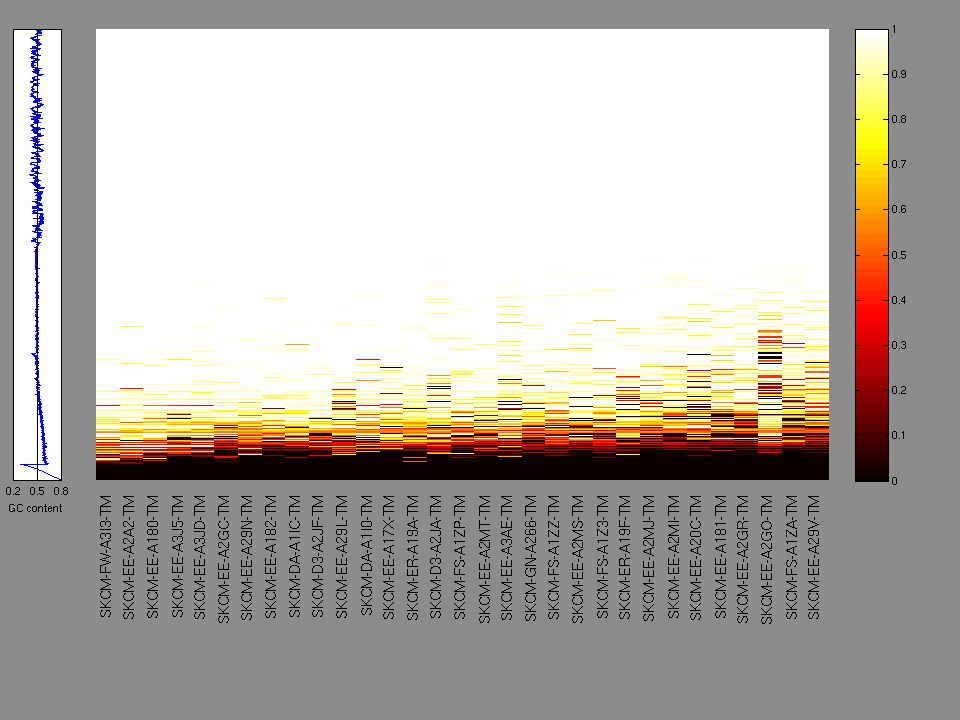
Figure 2. Patients counts and rates file used to generate this plot: SKCM-NF1_Any_Mutants.patients.counts_and_rates.txt
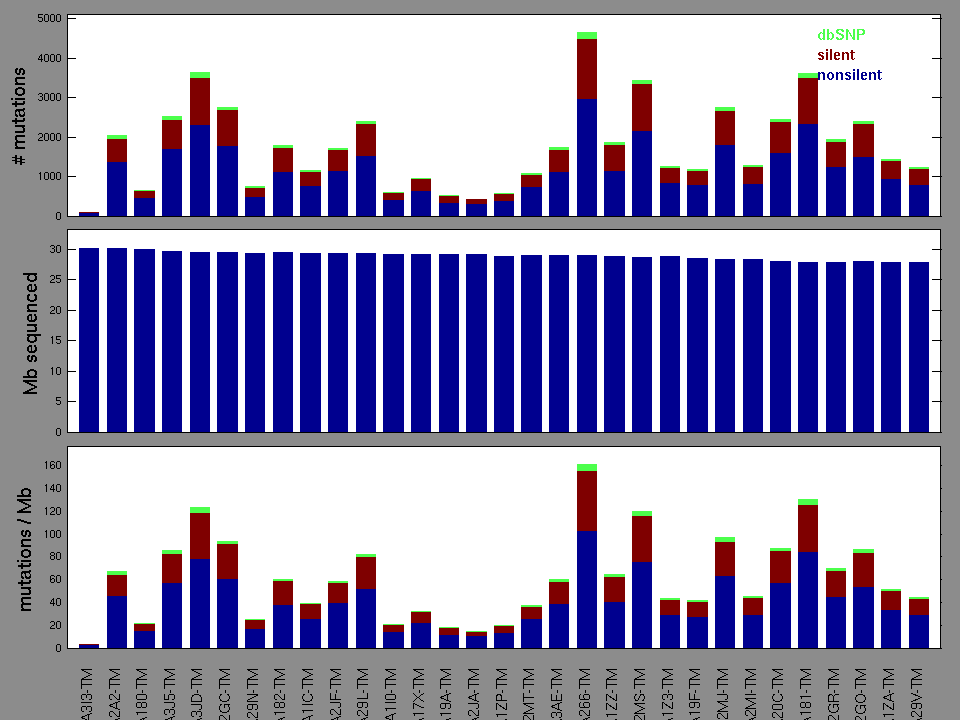
Figure 3. Get High-res Image The matrix in the center of the figure represents individual mutations in patient samples, color-coded by type of mutation, for the significantly mutated genes. The rate of synonymous and non-synonymous mutations is displayed at the top of the matrix. The barplot on the left of the matrix shows the number of mutations in each gene. The percentages represent the fraction of tumors with at least one mutation in the specified gene. The barplot to the right of the matrix displays the q-values for the most significantly mutated genes. The purple boxplots below the matrix (only displayed if required columns are present in the provided MAF) represent the distributions of allelic fractions observed in each sample. The plot at the bottom represents the base substitution distribution of individual samples, using the same categories that were used to calculate significance.
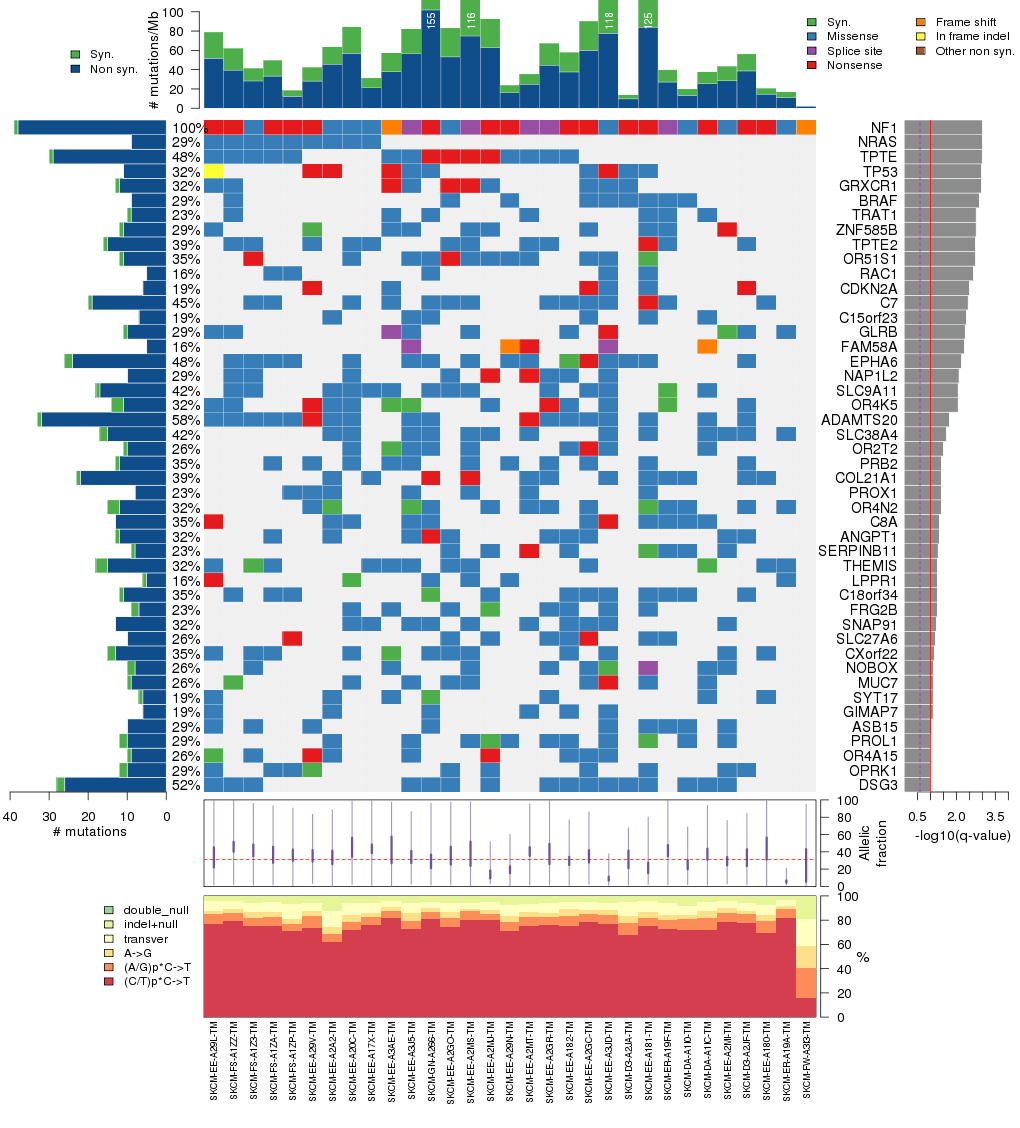
Column Descriptions:
-
N = number of sequenced bases in this gene across the individual set
-
n = number of (nonsilent) mutations in this gene across the individual set
-
npat = number of patients (individuals) with at least one nonsilent mutation
-
nsite = number of unique sites having a non-silent mutation
-
nsil = number of silent mutations in this gene across the individual set
-
n1 = number of nonsilent mutations of type: (C/T)p*C->T
-
n2 = number of nonsilent mutations of type: (A/G)p*C->T
-
n3 = number of nonsilent mutations of type: A->G
-
n4 = number of nonsilent mutations of type: transver
-
n5 = number of nonsilent mutations of type: indel+null
-
n6 = number of nonsilent mutations of type: double_null
-
p_classic = p-value for the observed amount of nonsilent mutations being elevated in this gene
-
p_ns_s = p-value for the observed nonsilent/silent ratio being elevated in this gene
-
p_cons = p-value for enrichment of mutations at evolutionarily most-conserved sites in gene
-
p_joint = p-value for clustering + conservation
-
p = p-value (overall)
-
q = q-value, False Discovery Rate (Benjamini-Hochberg procedure)
Table 3. Get Full Table A Ranked List of Significantly Mutated Genes. Number of significant genes found: 46. Number of genes displayed: 35. Click on a gene name to display its stick figure depicting the distribution of mutations and mutation types across the chosen gene (this feature may not be available for all significant genes).
| rank | gene | description | N | n | npat | nsite | nsil | n1 | n2 | n3 | n4 | n5 | n6 | p_classic | p_ns_s | p_cons | p_joint | p | q |
|---|---|---|---|---|---|---|---|---|---|---|---|---|---|---|---|---|---|---|---|
| 1 | NF1 | neurofibromin 1 (neurofibromatosis, von Recklinghausen disease, Watson disease) | 265976 | 38 | 31 | 36 | 1 | 12 | 0 | 1 | 3 | 18 | 4 | 3.7e-15 | 0.000024 | 1 | 1 | 1.2e-13 | 2.3e-09 |
| 2 | NRAS | neuroblastoma RAS viral (v-ras) oncogene homolog | 18116 | 9 | 9 | 6 | 0 | 1 | 0 | 1 | 7 | 0 | 0 | 3.2e-11 | 0.14 | 0.17 | 0.00054 | 5.7e-13 | 5.1e-09 |
| 3 | TPTE | transmembrane phosphatase with tensin homology | 53920 | 29 | 15 | 27 | 1 | 24 | 0 | 1 | 0 | 4 | 0 | 1.4e-10 | 0.00033 | 0.58 | 0.57 | 1.9e-09 | 0.000012 |
| 4 | TP53 | tumor protein p53 | 37759 | 11 | 10 | 10 | 0 | 4 | 0 | 0 | 2 | 5 | 0 | 9.7e-08 | 0.025 | 0.2 | 0.0072 | 1.5e-08 | 0.000069 |
| 5 | GRXCR1 | glutaredoxin, cysteine rich 1 | 26704 | 12 | 10 | 11 | 1 | 5 | 1 | 2 | 1 | 3 | 0 | 1e-09 | 0.052 | 0.73 | 0.87 | 2e-08 | 0.000071 |
| 6 | BRAF | v-raf murine sarcoma viral oncogene homolog B1 | 68906 | 9 | 9 | 6 | 0 | 6 | 0 | 1 | 2 | 0 | 0 | 0.00016 | 0.057 | 0.079 | 0.000025 | 8.1e-08 | 0.00024 |
| 7 | TRAT1 | T cell receptor associated transmembrane adaptor 1 | 18135 | 9 | 7 | 6 | 1 | 7 | 1 | 1 | 0 | 0 | 0 | 1.9e-06 | 0.11 | 0.078 | 0.0081 | 2.9e-07 | 0.00073 |
| 8 | ZNF585B | zinc finger protein 585B | 70432 | 11 | 9 | 10 | 1 | 7 | 2 | 1 | 0 | 1 | 0 | 0.00022 | 0.051 | 0.086 | 0.000079 | 3.2e-07 | 0.00073 |
| 9 | TPTE2 | transmembrane phosphoinositide 3-phosphatase and tensin homolog 2 | 50530 | 15 | 12 | 14 | 1 | 11 | 2 | 0 | 1 | 1 | 0 | 3.4e-08 | 0.035 | 0.86 | 0.66 | 4.2e-07 | 0.00085 |
| 10 | OR51S1 | olfactory receptor, family 51, subfamily S, member 1 | 30128 | 11 | 11 | 9 | 1 | 8 | 0 | 0 | 1 | 2 | 0 | 1.3e-07 | 0.0089 | 0.89 | 0.2 | 4.7e-07 | 0.00085 |
| 11 | RAC1 | ras-related C3 botulinum toxin substrate 1 (rho family, small GTP binding protein Rac1) | 19060 | 5 | 5 | 2 | 0 | 5 | 0 | 0 | 0 | 0 | 0 | 0.0023 | 0.08 | 0.19 | 0.000017 | 7.2e-07 | 0.0012 |
| 12 | CDKN2A | cyclin-dependent kinase inhibitor 2A (melanoma, p16, inhibits CDK4) | 27643 | 6 | 6 | 4 | 0 | 2 | 0 | 0 | 1 | 3 | 0 | 0.00022 | 0.14 | 0.00013 | 0.00037 | 1.4e-06 | 0.0021 |
| 13 | C7 | complement component 7 | 65059 | 19 | 14 | 17 | 1 | 17 | 1 | 0 | 0 | 1 | 0 | 3.6e-06 | 0.013 | 0.51 | 0.03 | 1.8e-06 | 0.0025 |
| 14 | C15orf23 | chromosome 15 open reading frame 23 | 31624 | 7 | 6 | 3 | 0 | 7 | 0 | 0 | 0 | 0 | 0 | 0.0058 | 0.042 | 1 | 0.000023 | 2.3e-06 | 0.0029 |
| 15 | GLRB | glycine receptor, beta | 45005 | 10 | 9 | 9 | 1 | 7 | 0 | 1 | 0 | 2 | 0 | 0.000018 | 0.05 | 0.093 | 0.01 | 3e-06 | 0.0036 |
| 16 | FAM58A | family with sequence similarity 58, member A | 18604 | 5 | 5 | 4 | 0 | 0 | 0 | 0 | 0 | 5 | 0 | 0.000012 | 0.26 | 0.085 | 0.017 | 3.3e-06 | 0.0038 |
| 17 | EPHA6 | EPH receptor A6 | 95264 | 24 | 15 | 19 | 2 | 21 | 0 | 0 | 2 | 1 | 0 | 0.00017 | 0.0043 | 0.49 | 0.0019 | 5e-06 | 0.0053 |
| 18 | NAP1L2 | nucleosome assembly protein 1-like 2 | 42424 | 10 | 9 | 10 | 0 | 5 | 0 | 2 | 1 | 2 | 0 | 2.3e-06 | 0.033 | 0.46 | 0.19 | 6.9e-06 | 0.0069 |
| 19 | SLC9A11 | solute carrier family 9, member 11 | 105541 | 17 | 13 | 15 | 1 | 13 | 0 | 2 | 2 | 0 | 0 | 0.000012 | 0.012 | 0.85 | 0.043 | 8.2e-06 | 0.0076 |
| 20 | OR4K5 | olfactory receptor, family 4, subfamily K, member 5 | 30194 | 11 | 10 | 11 | 3 | 3 | 0 | 1 | 5 | 2 | 0 | 8.5e-07 | 0.27 | 0.36 | 0.64 | 8.4e-06 | 0.0076 |
| 21 | ADAMTS20 | ADAM metallopeptidase with thrombospondin type 1 motif, 20 | 153071 | 32 | 18 | 31 | 1 | 28 | 1 | 0 | 1 | 2 | 0 | 6.8e-06 | 0.0015 | 0.097 | 0.2 | 2e-05 | 0.017 |
| 22 | SLC38A4 | solute carrier family 38, member 4 | 47556 | 15 | 13 | 13 | 2 | 13 | 0 | 0 | 2 | 0 | 0 | 4.4e-06 | 0.046 | 0.95 | 0.44 | 0.000028 | 0.023 |
| 23 | OR2T2 | olfactory receptor, family 2, subfamily T, member 2 | 27909 | 10 | 8 | 9 | 1 | 7 | 1 | 1 | 0 | 1 | 0 | 0.000013 | 0.007 | 0.48 | 0.21 | 0.000038 | 0.03 |
| 24 | PRB2 | proline-rich protein BstNI subfamily 2 | 38658 | 12 | 11 | 12 | 1 | 11 | 0 | 0 | 1 | 0 | 0 | 0.000035 | 0.5 | 0.79 | 0.1 | 0.000048 | 0.036 |
| 25 | COL21A1 | collagen, type XXI, alpha 1 | 63654 | 22 | 12 | 22 | 1 | 19 | 1 | 0 | 0 | 2 | 0 | 3.9e-06 | 0.042 | 0.46 | 1 | 0.000053 | 0.037 |
| 26 | PROX1 | prospero homeobox 1 | 69130 | 8 | 7 | 7 | 0 | 7 | 0 | 0 | 1 | 0 | 0 | 0.021 | 0.031 | 0.8 | 0.00019 | 0.000054 | 0.037 |
| 27 | OR4N2 | olfactory receptor, family 4, subfamily N, member 2 | 28702 | 12 | 10 | 9 | 3 | 12 | 0 | 0 | 0 | 0 | 0 | 0.000011 | 0.017 | 0.18 | 0.39 | 0.000055 | 0.037 |
| 28 | C8A | complement component 8, alpha polypeptide | 52887 | 13 | 11 | 12 | 0 | 10 | 0 | 0 | 1 | 2 | 0 | 7.4e-06 | 0.0061 | 0.88 | 0.73 | 7e-05 | 0.044 |
| 29 | ANGPT1 | angiopoietin 1 | 47231 | 12 | 10 | 11 | 1 | 9 | 0 | 0 | 2 | 1 | 0 | 0.000012 | 0.079 | 0.52 | 0.44 | 0.000071 | 0.044 |
| 30 | SERPINB11 | serpin peptidase inhibitor, clade B (ovalbumin), member 11 | 29826 | 8 | 7 | 8 | 1 | 5 | 2 | 0 | 0 | 1 | 0 | 8.4e-06 | 0.1 | 0.48 | 0.75 | 0.000082 | 0.049 |
| 31 | THEMIS | thymocyte selection associated | 57922 | 15 | 10 | 13 | 3 | 12 | 0 | 1 | 2 | 0 | 0 | 0.0009 | 0.12 | 0.48 | 0.0082 | 0.000094 | 0.053 |
| 32 | LPPR1 | 31143 | 5 | 5 | 5 | 1 | 4 | 0 | 0 | 0 | 1 | 0 | 0.0043 | 0.18 | 0.47 | 0.0017 | 0.000094 | 0.053 | |
| 33 | C18orf34 | chromosome 18 open reading frame 34 | 76034 | 11 | 11 | 11 | 1 | 8 | 1 | 0 | 2 | 0 | 0 | 2e-05 | 0.097 | 0.4 | 0.38 | 0.000099 | 0.053 |
| 34 | FRG2B | FSHD region gene 2 family, member B | 16484 | 7 | 7 | 5 | 2 | 5 | 1 | 0 | 1 | 0 | 0 | 0.000049 | 0.33 | 0.97 | 0.16 | 0.000099 | 0.053 |
| 35 | SNAP91 | synaptosomal-associated protein, 91kDa homolog (mouse) | 49635 | 13 | 10 | 13 | 0 | 10 | 2 | 1 | 0 | 0 | 0 | 0.000015 | 0.013 | 0.95 | 0.6 | 0.00011 | 0.057 |
Figure S1. This figure depicts the distribution of mutations and mutation types across the NF1 significant gene.
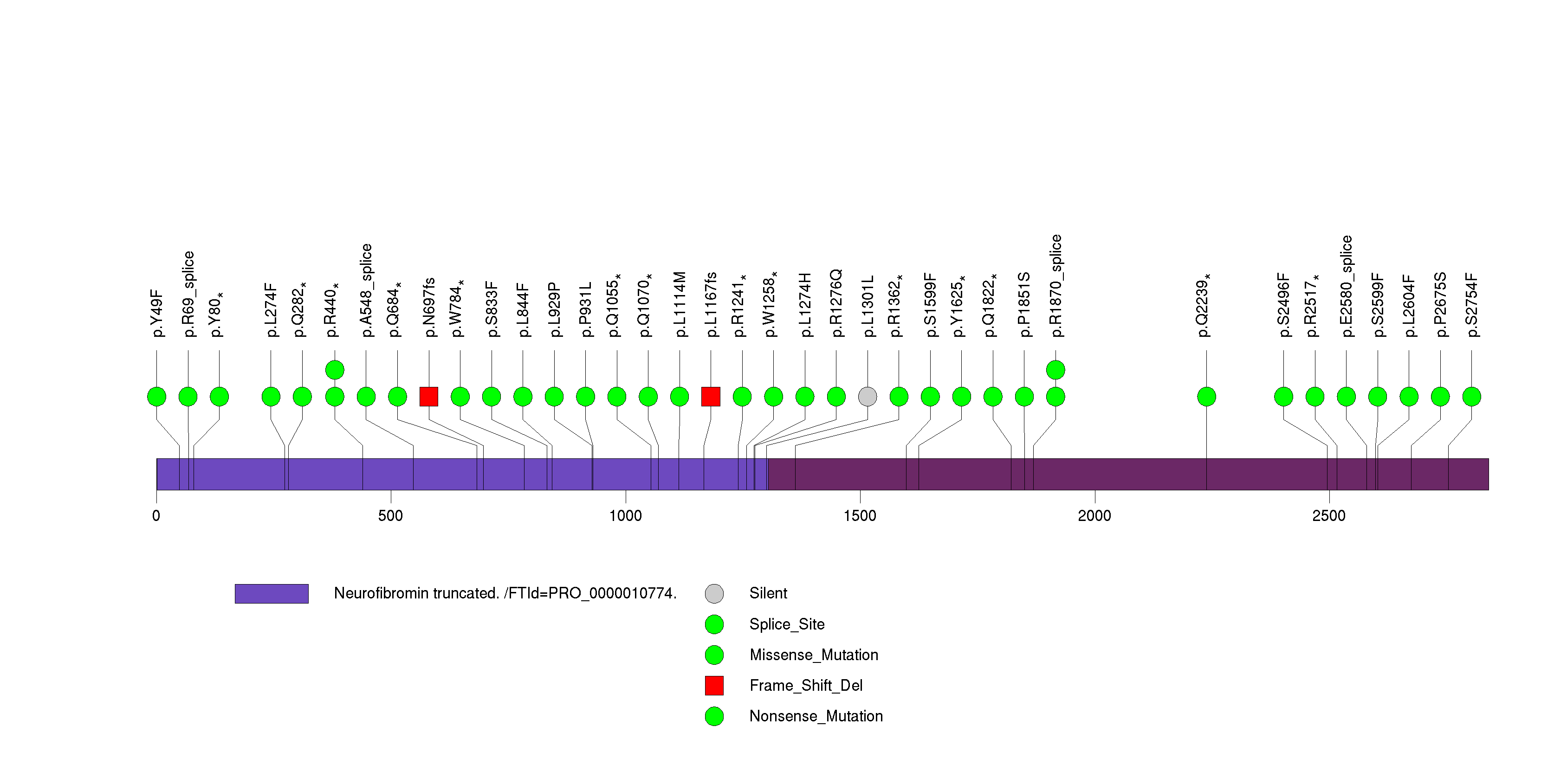
Figure S2. This figure depicts the distribution of mutations and mutation types across the NRAS significant gene.

Figure S3. This figure depicts the distribution of mutations and mutation types across the TPTE significant gene.
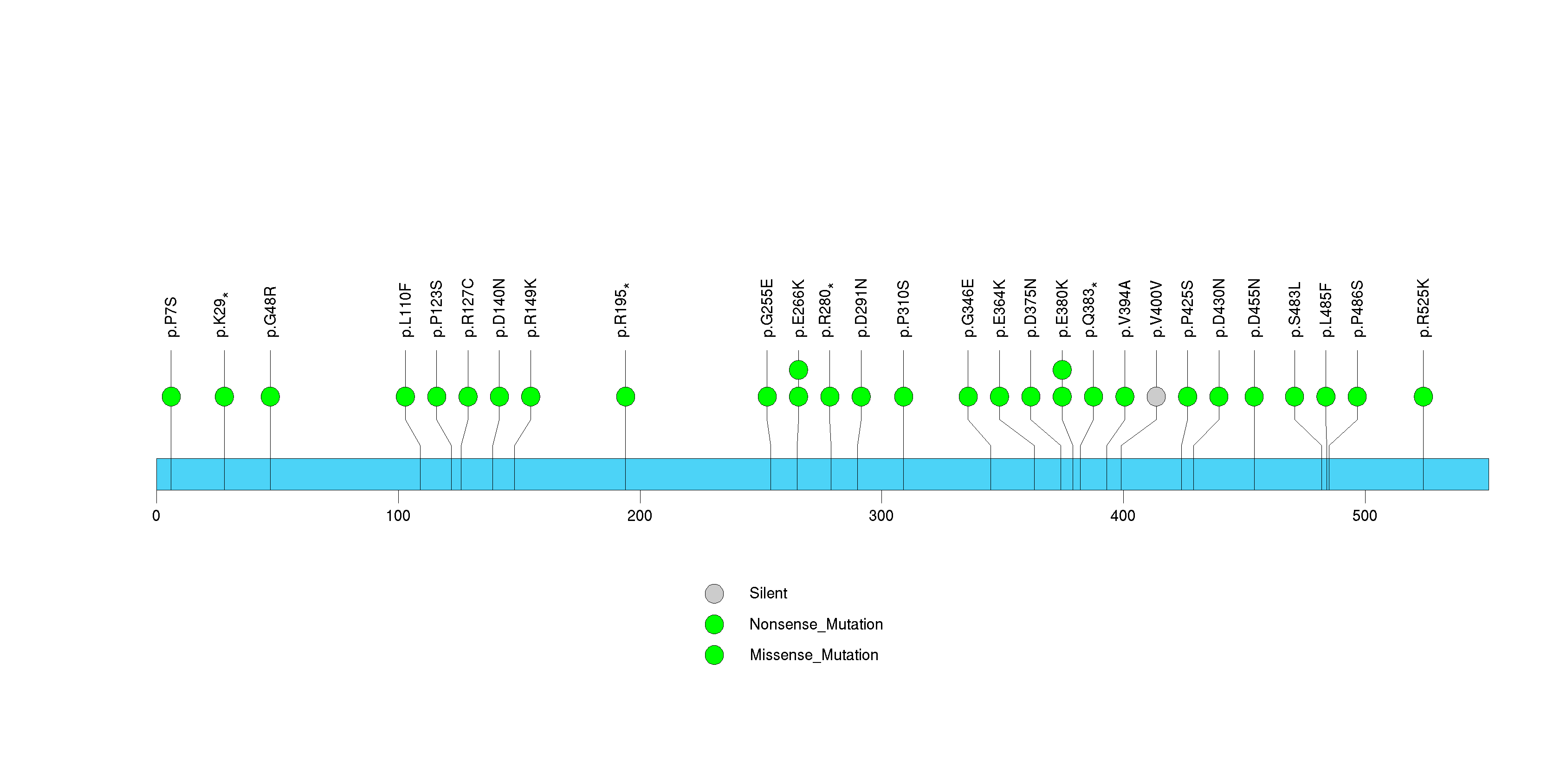
Figure S4. This figure depicts the distribution of mutations and mutation types across the TP53 significant gene.

Figure S5. This figure depicts the distribution of mutations and mutation types across the GRXCR1 significant gene.
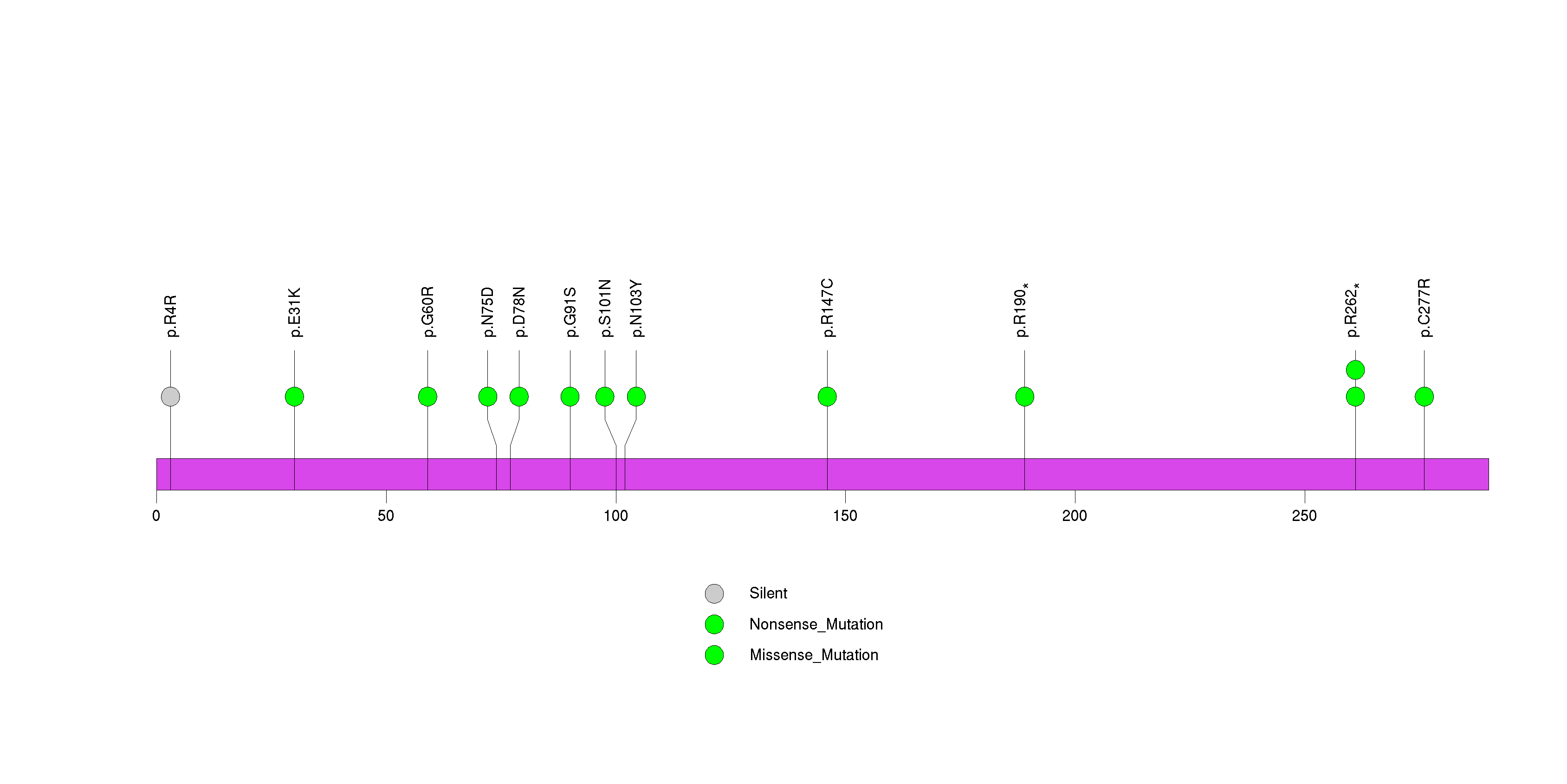
Figure S6. This figure depicts the distribution of mutations and mutation types across the BRAF significant gene.
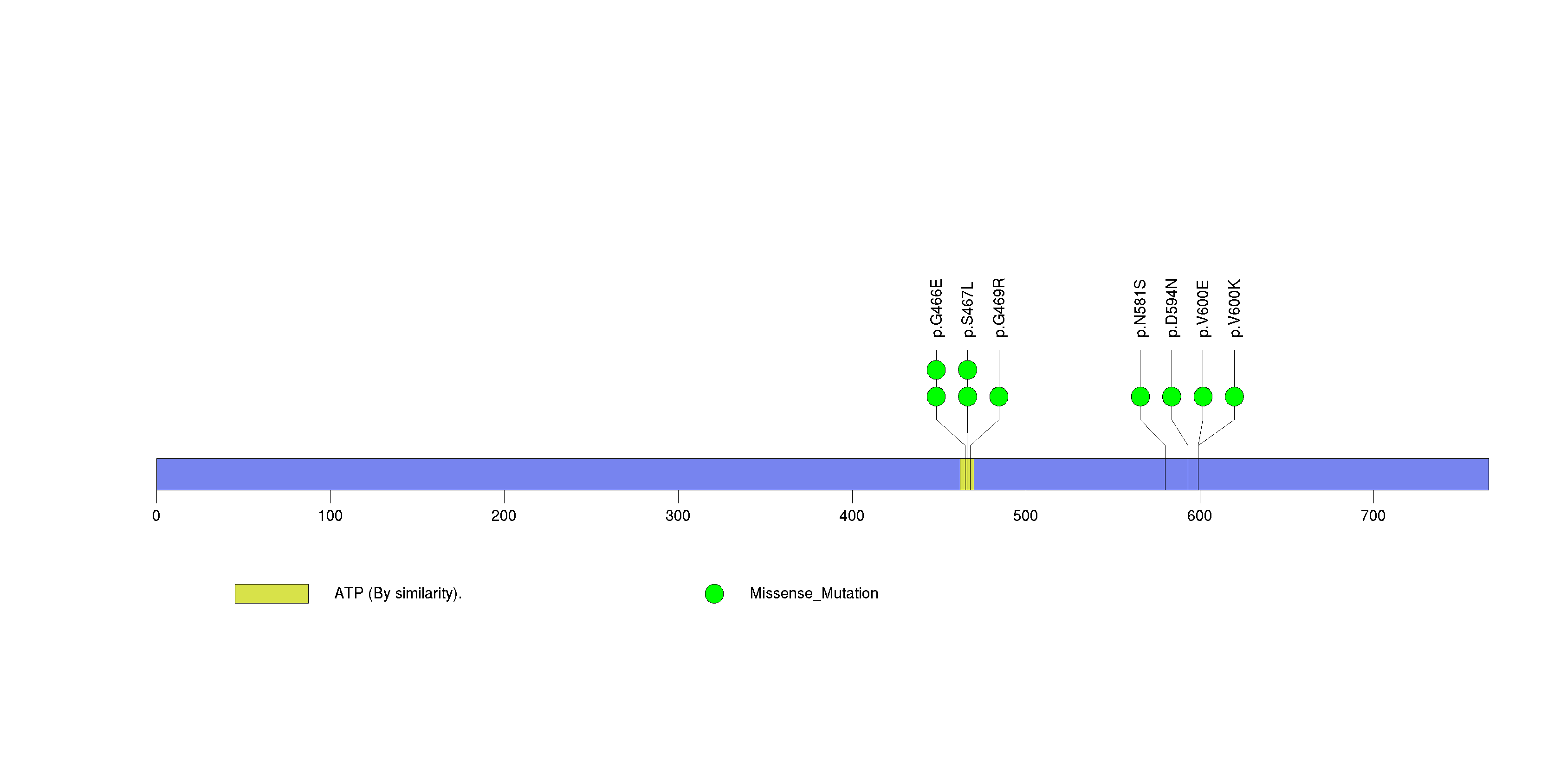
Figure S7. This figure depicts the distribution of mutations and mutation types across the TRAT1 significant gene.

Figure S8. This figure depicts the distribution of mutations and mutation types across the ZNF585B significant gene.
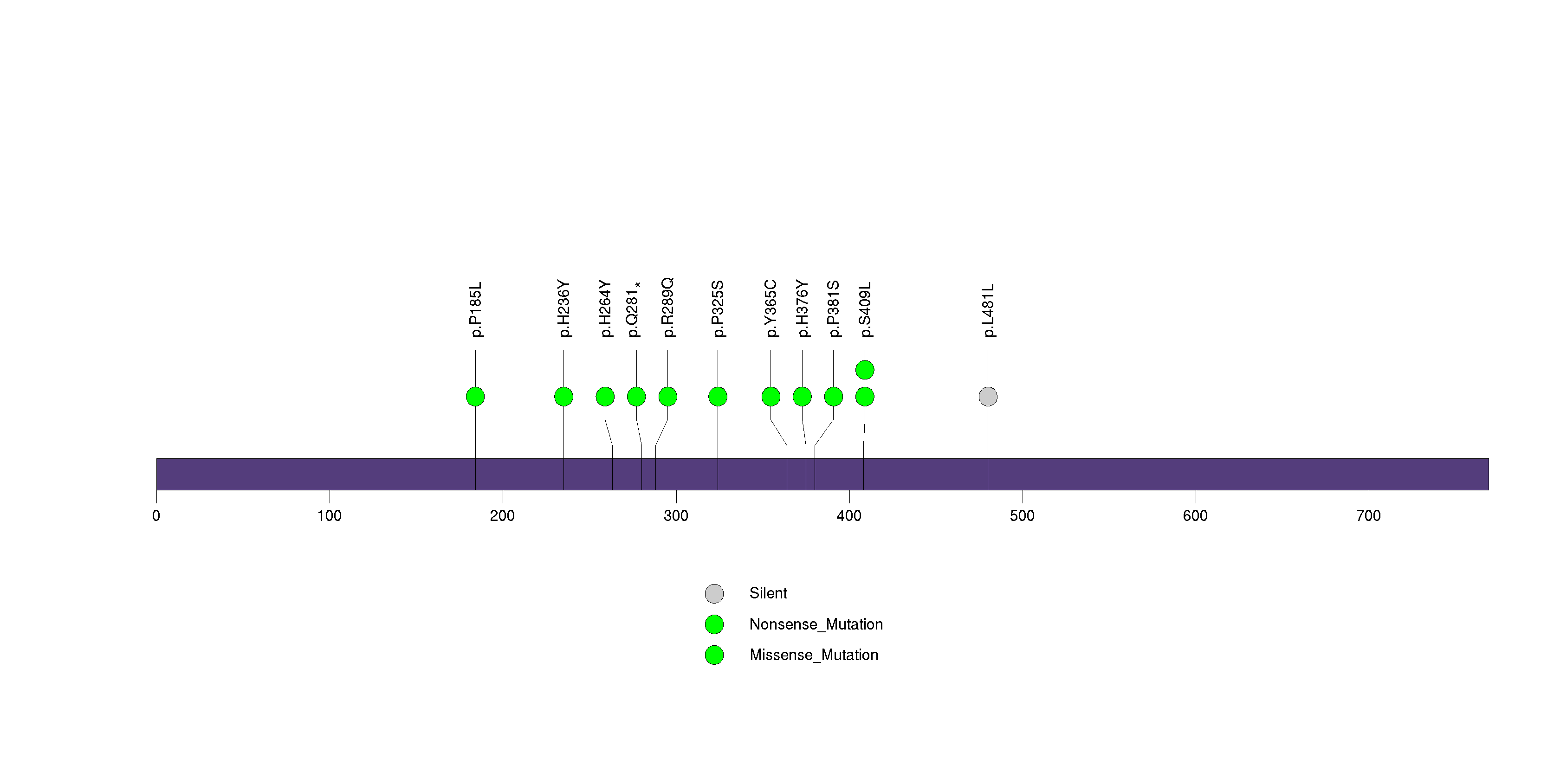
Figure S9. This figure depicts the distribution of mutations and mutation types across the TPTE2 significant gene.
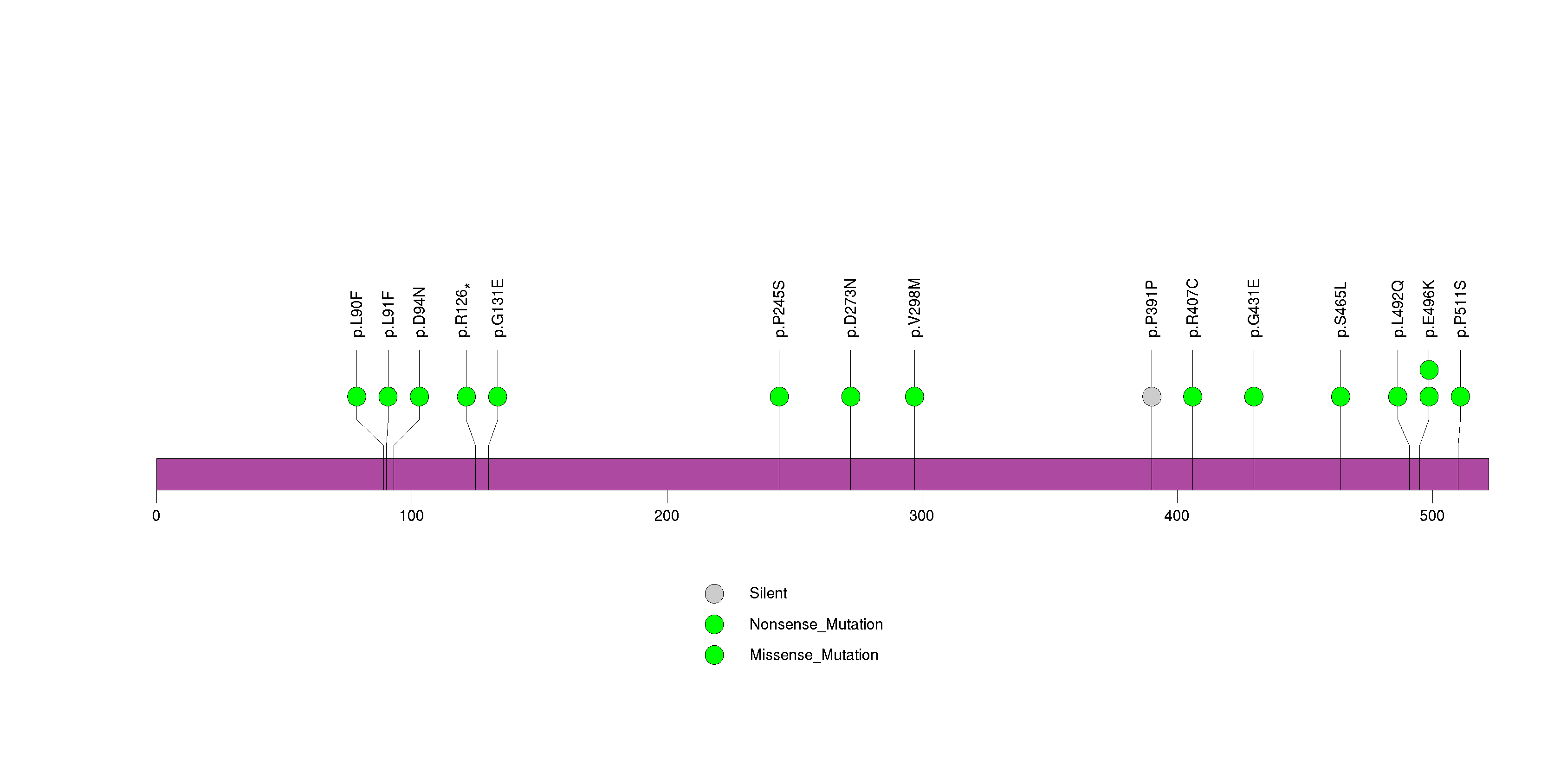
Figure S10. This figure depicts the distribution of mutations and mutation types across the OR51S1 significant gene.
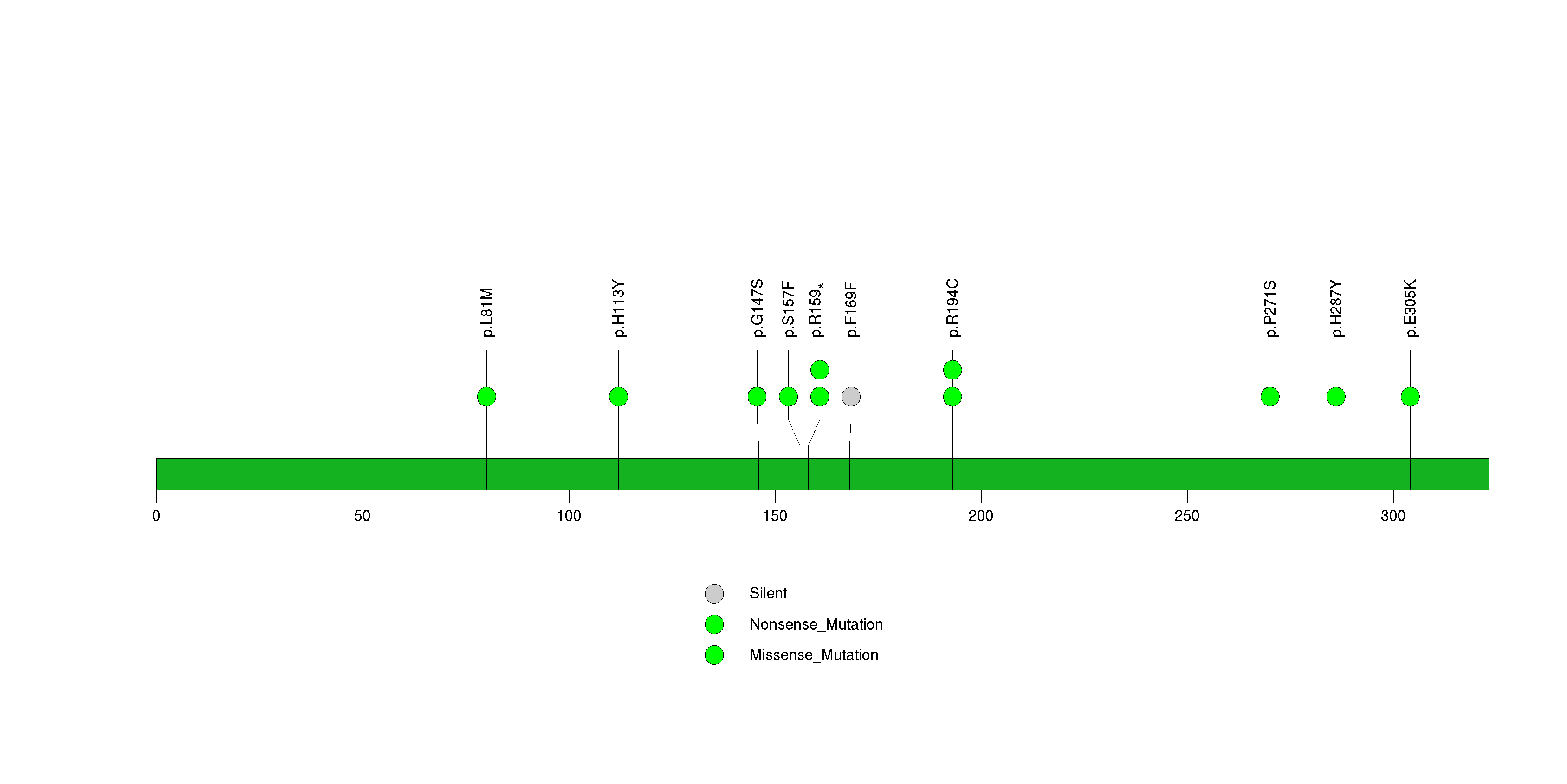
Figure S11. This figure depicts the distribution of mutations and mutation types across the RAC1 significant gene.
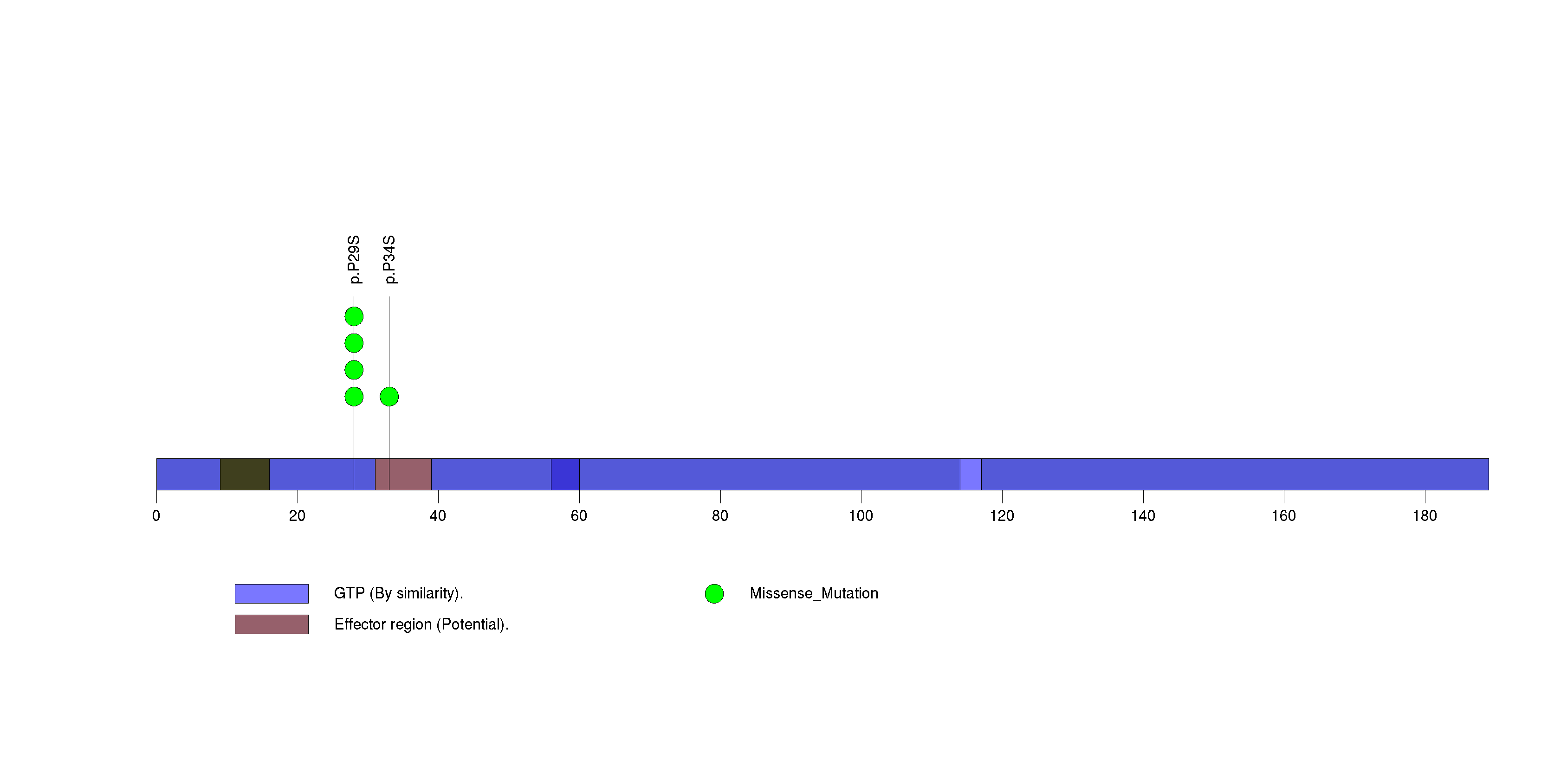
Figure S12. This figure depicts the distribution of mutations and mutation types across the CDKN2A significant gene.

Figure S13. This figure depicts the distribution of mutations and mutation types across the C7 significant gene.
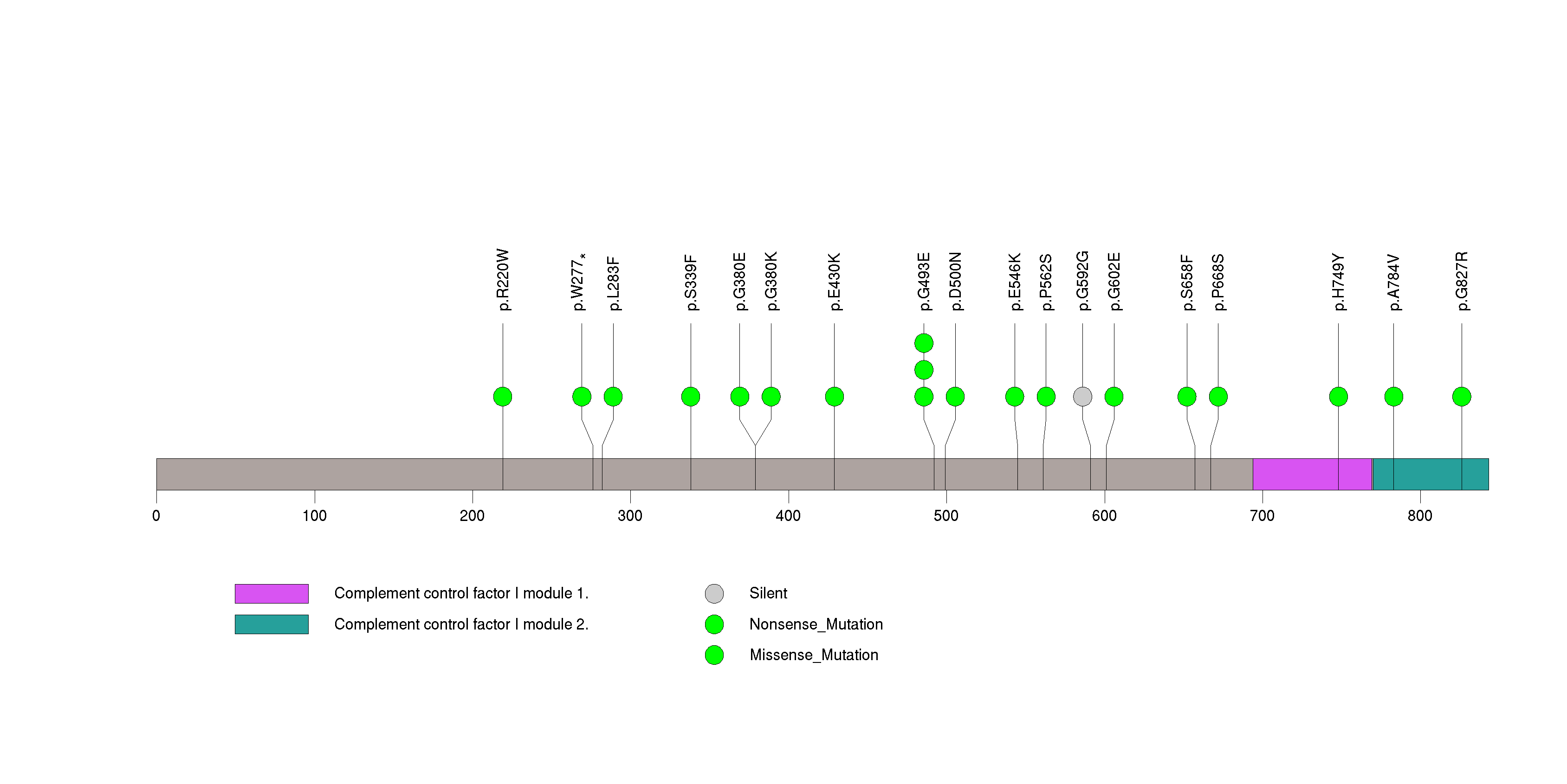
Figure S14. This figure depicts the distribution of mutations and mutation types across the C15orf23 significant gene.
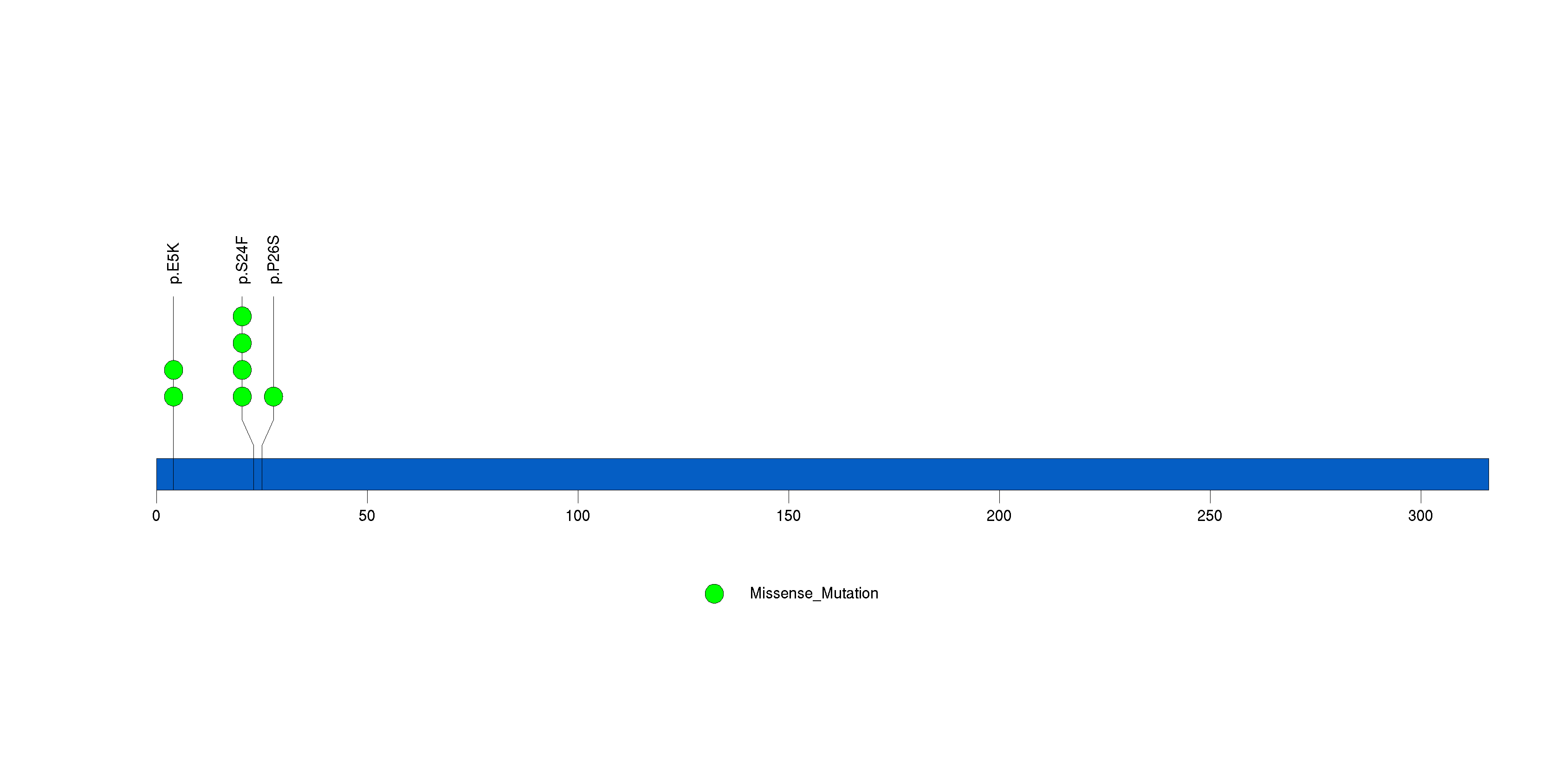
Figure S15. This figure depicts the distribution of mutations and mutation types across the GLRB significant gene.
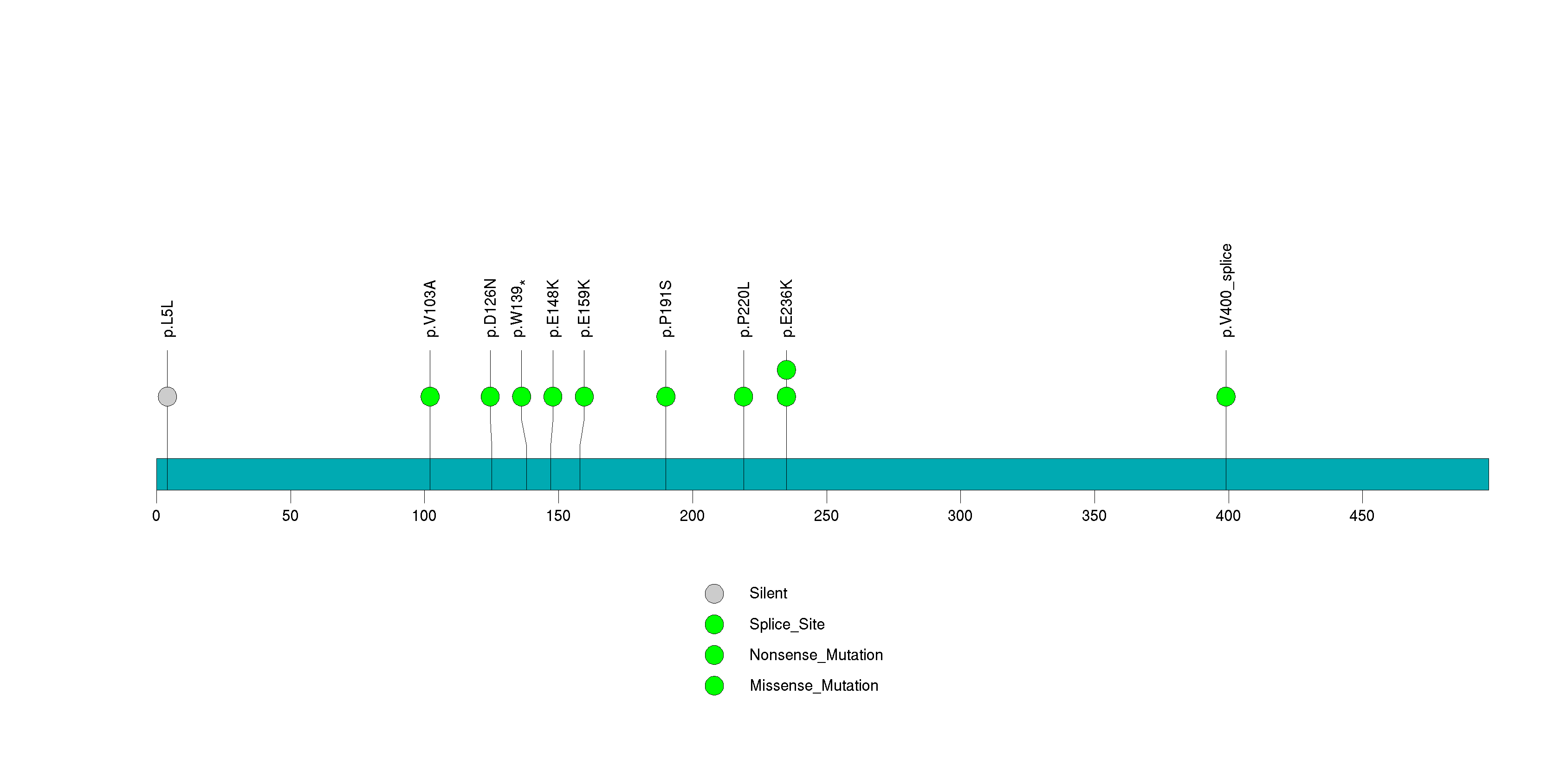
Figure S16. This figure depicts the distribution of mutations and mutation types across the FAM58A significant gene.
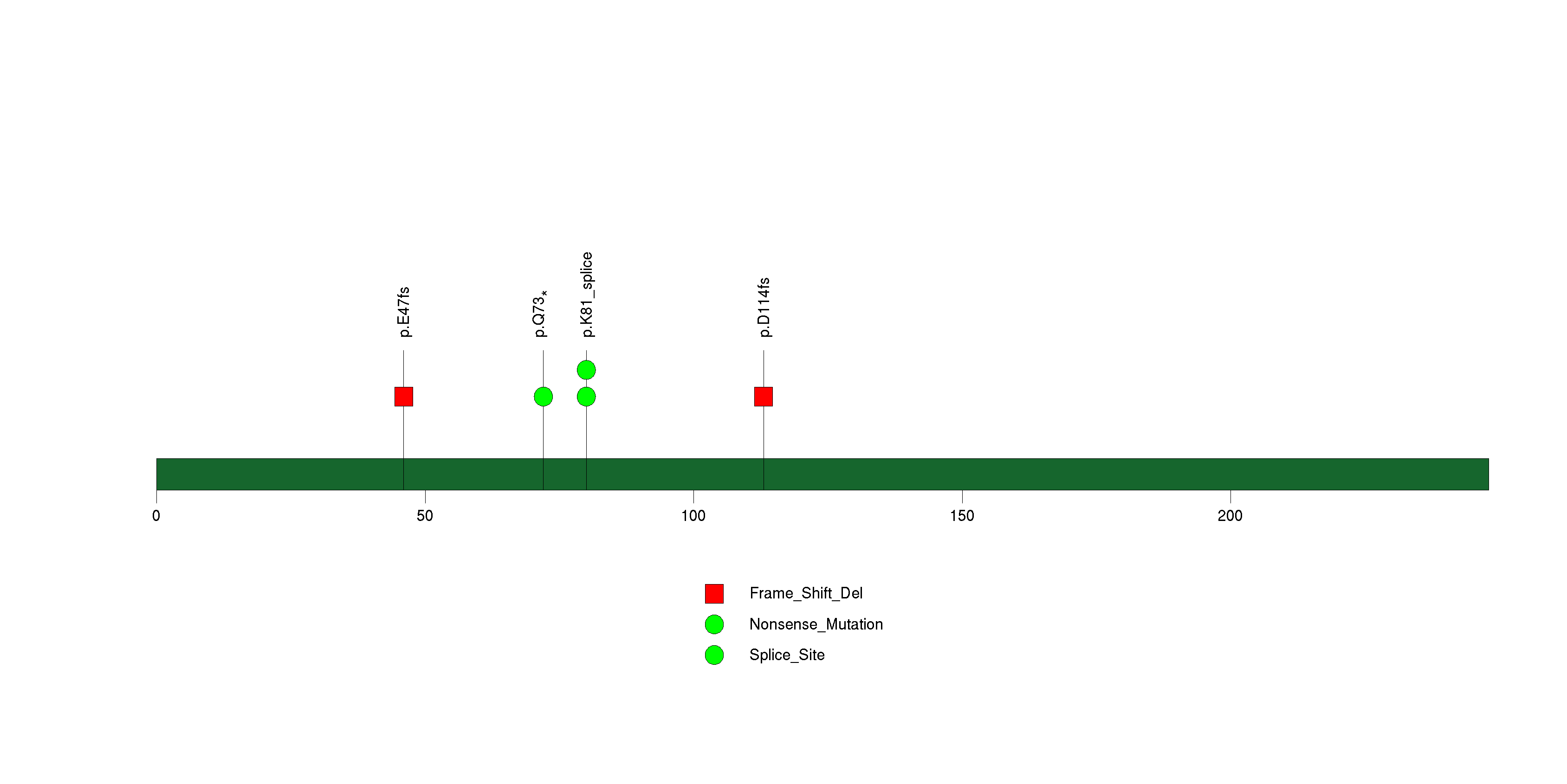
Figure S17. This figure depicts the distribution of mutations and mutation types across the EPHA6 significant gene.
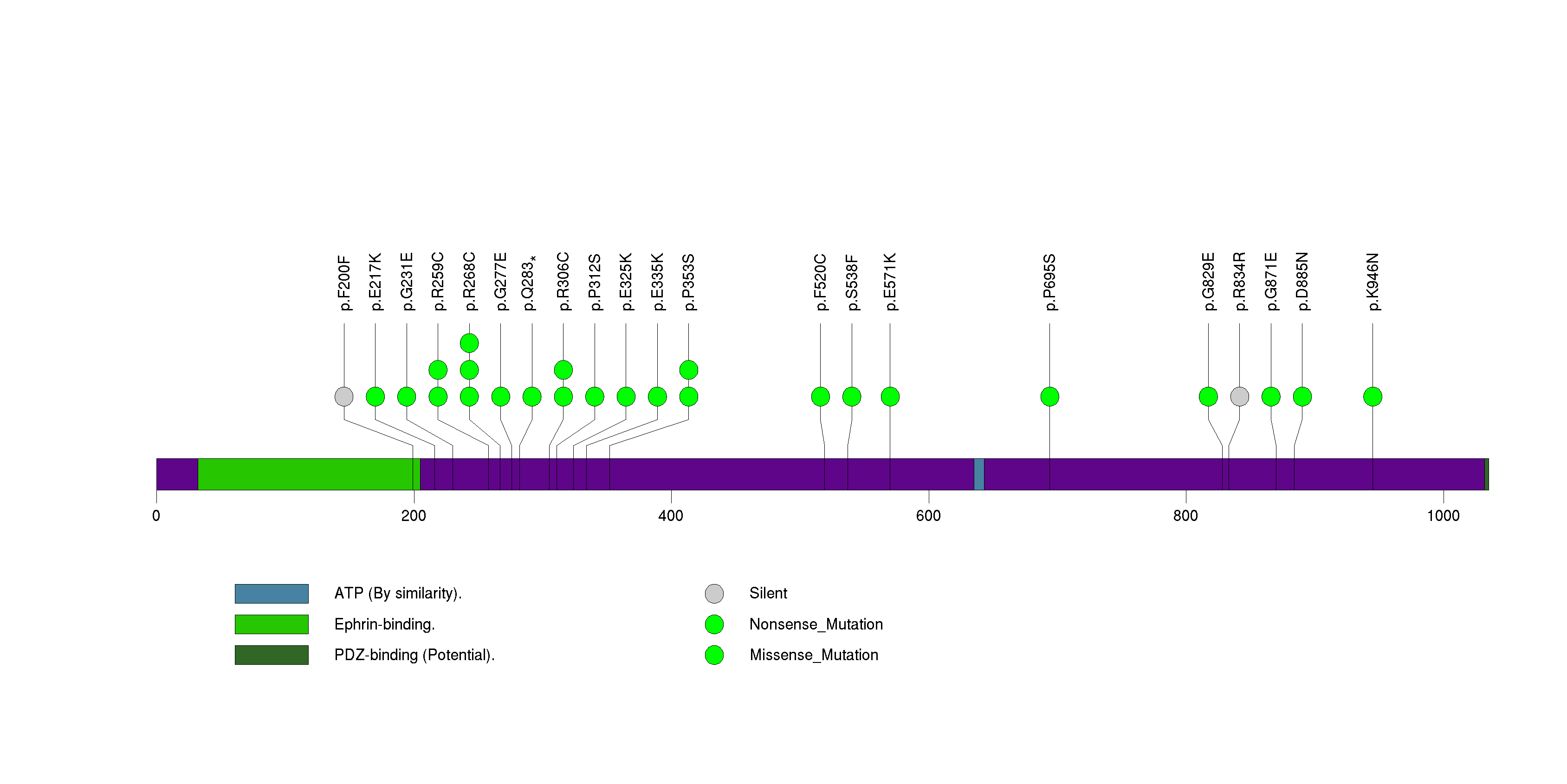
Figure S18. This figure depicts the distribution of mutations and mutation types across the NAP1L2 significant gene.

Figure S19. This figure depicts the distribution of mutations and mutation types across the SLC9A11 significant gene.

Figure S20. This figure depicts the distribution of mutations and mutation types across the OR4K5 significant gene.
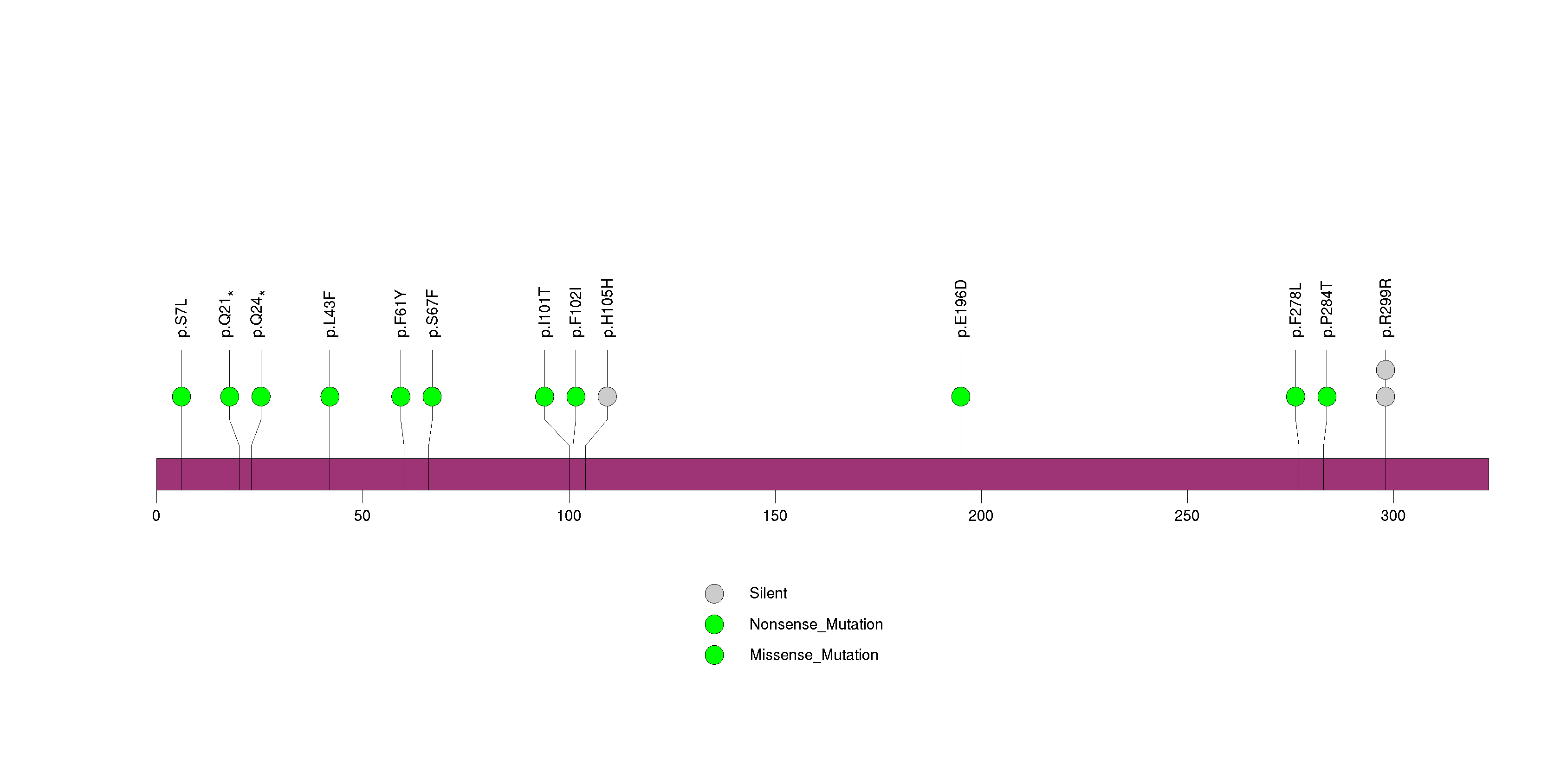
Figure S21. This figure depicts the distribution of mutations and mutation types across the ADAMTS20 significant gene.
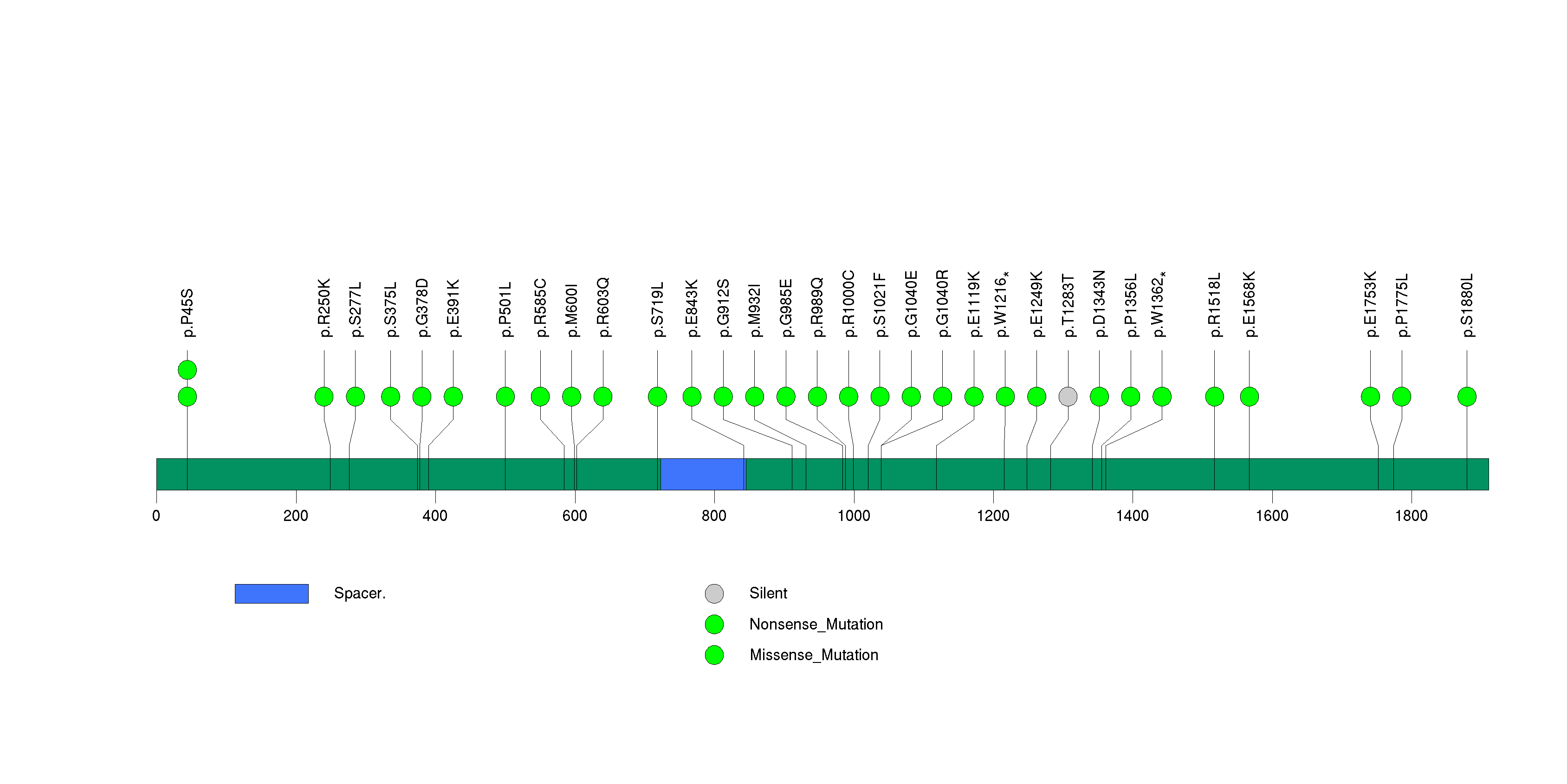
Figure S22. This figure depicts the distribution of mutations and mutation types across the SLC38A4 significant gene.
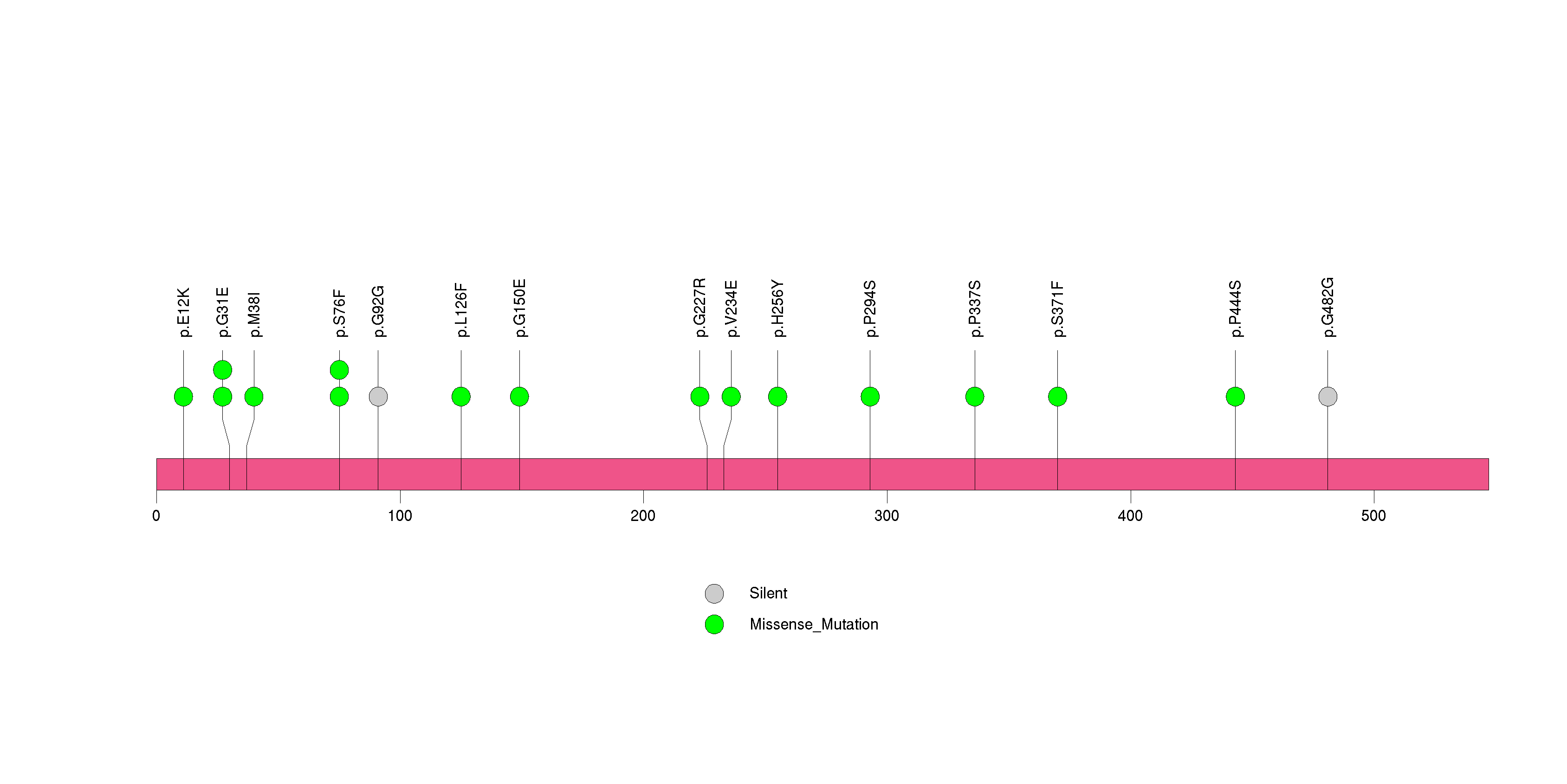
Figure S23. This figure depicts the distribution of mutations and mutation types across the OR2T2 significant gene.
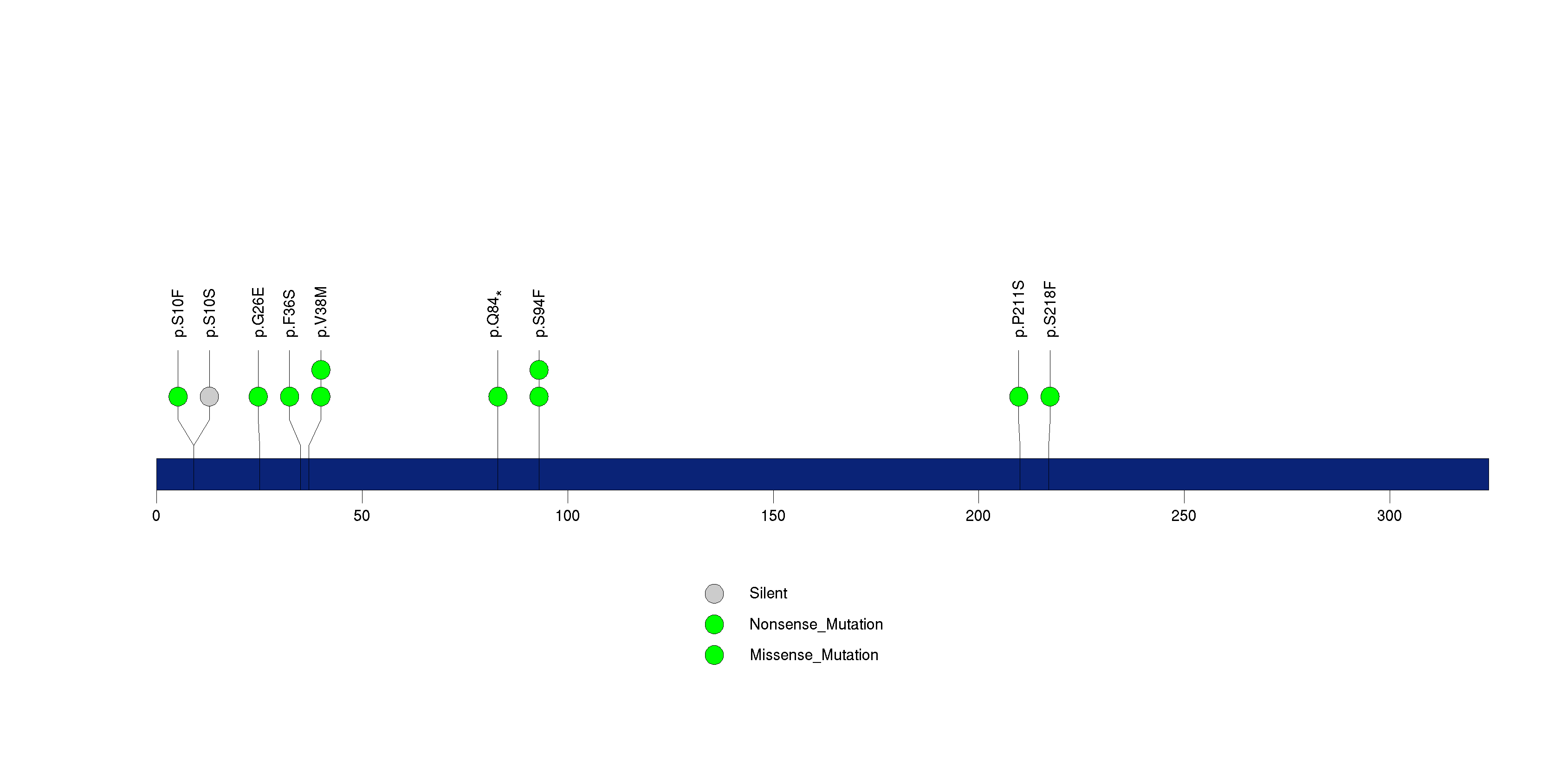
Figure S24. This figure depicts the distribution of mutations and mutation types across the COL21A1 significant gene.

Figure S25. This figure depicts the distribution of mutations and mutation types across the PROX1 significant gene.
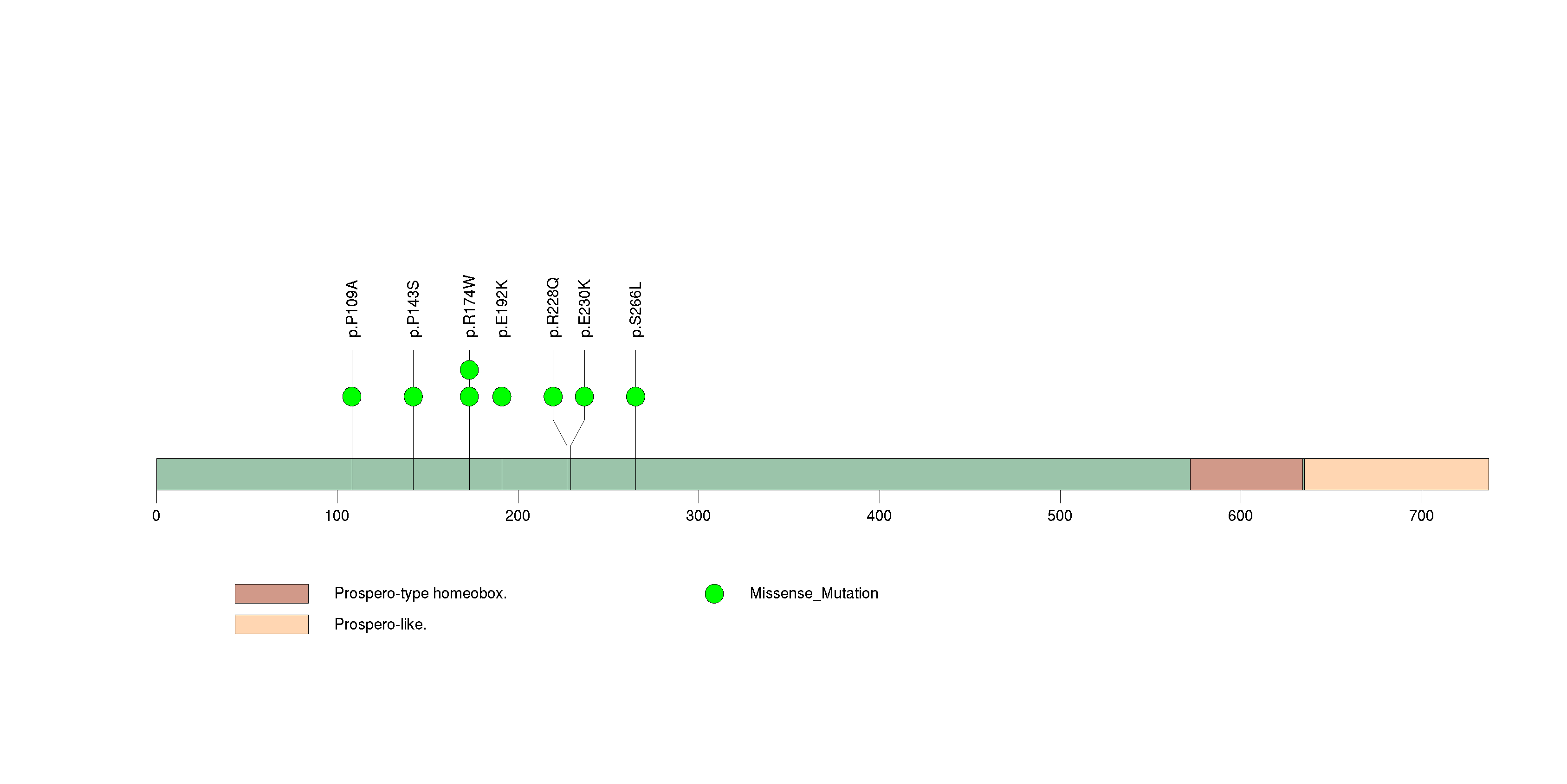
Figure S26. This figure depicts the distribution of mutations and mutation types across the OR4N2 significant gene.
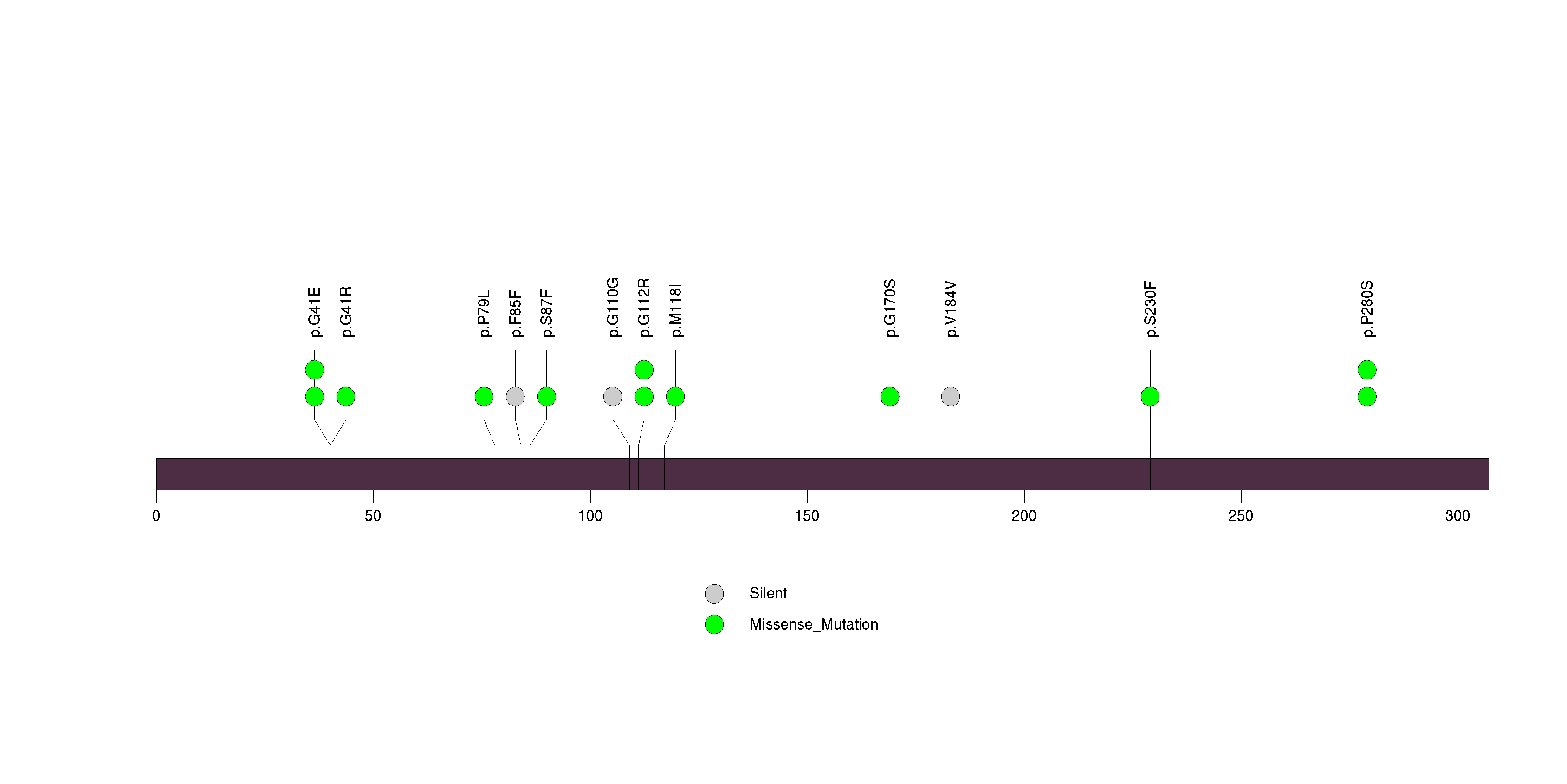
Figure S27. This figure depicts the distribution of mutations and mutation types across the C8A significant gene.
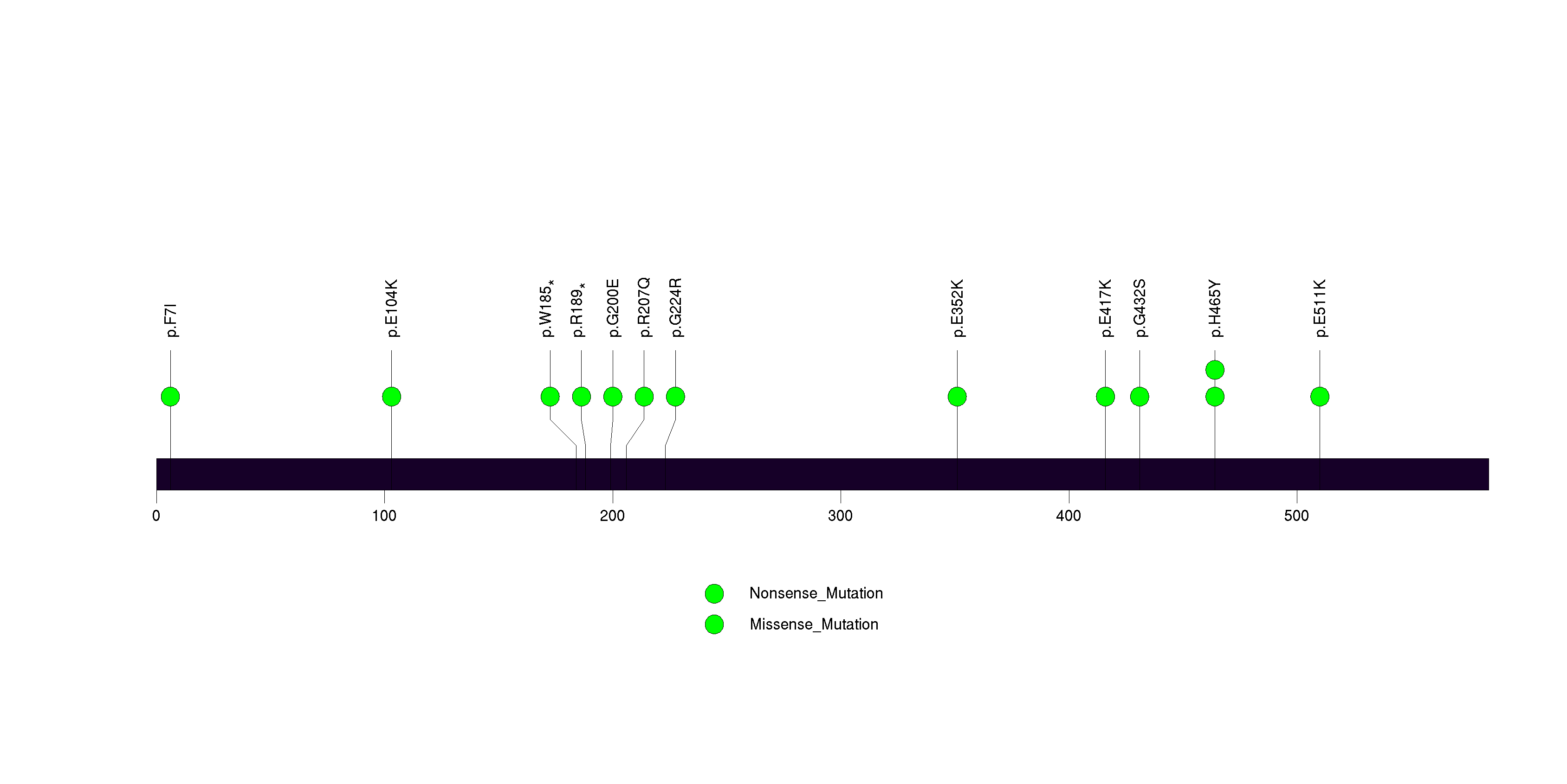
Figure S28. This figure depicts the distribution of mutations and mutation types across the ANGPT1 significant gene.

Figure S29. This figure depicts the distribution of mutations and mutation types across the SERPINB11 significant gene.
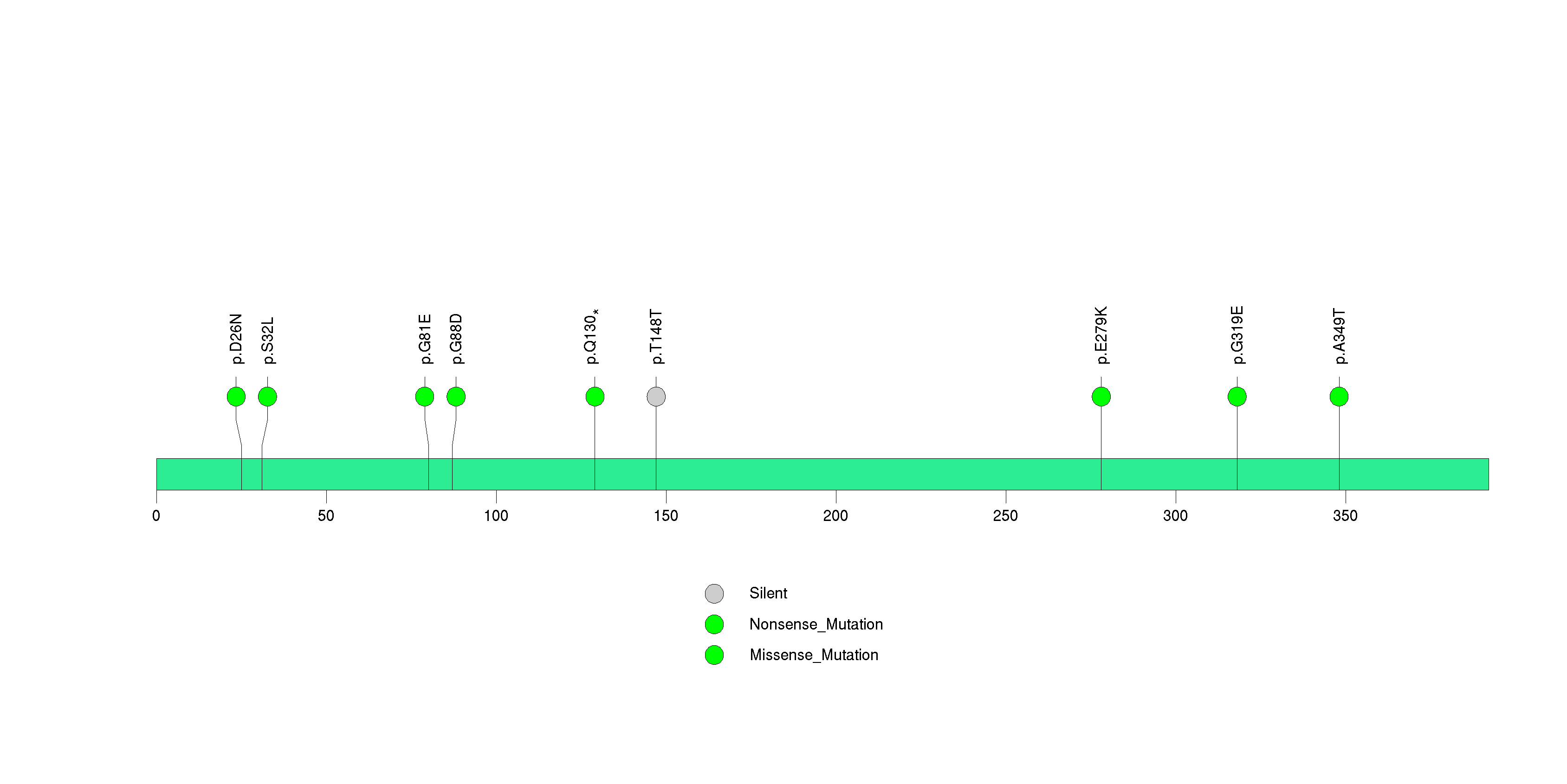
Figure S30. This figure depicts the distribution of mutations and mutation types across the THEMIS significant gene.
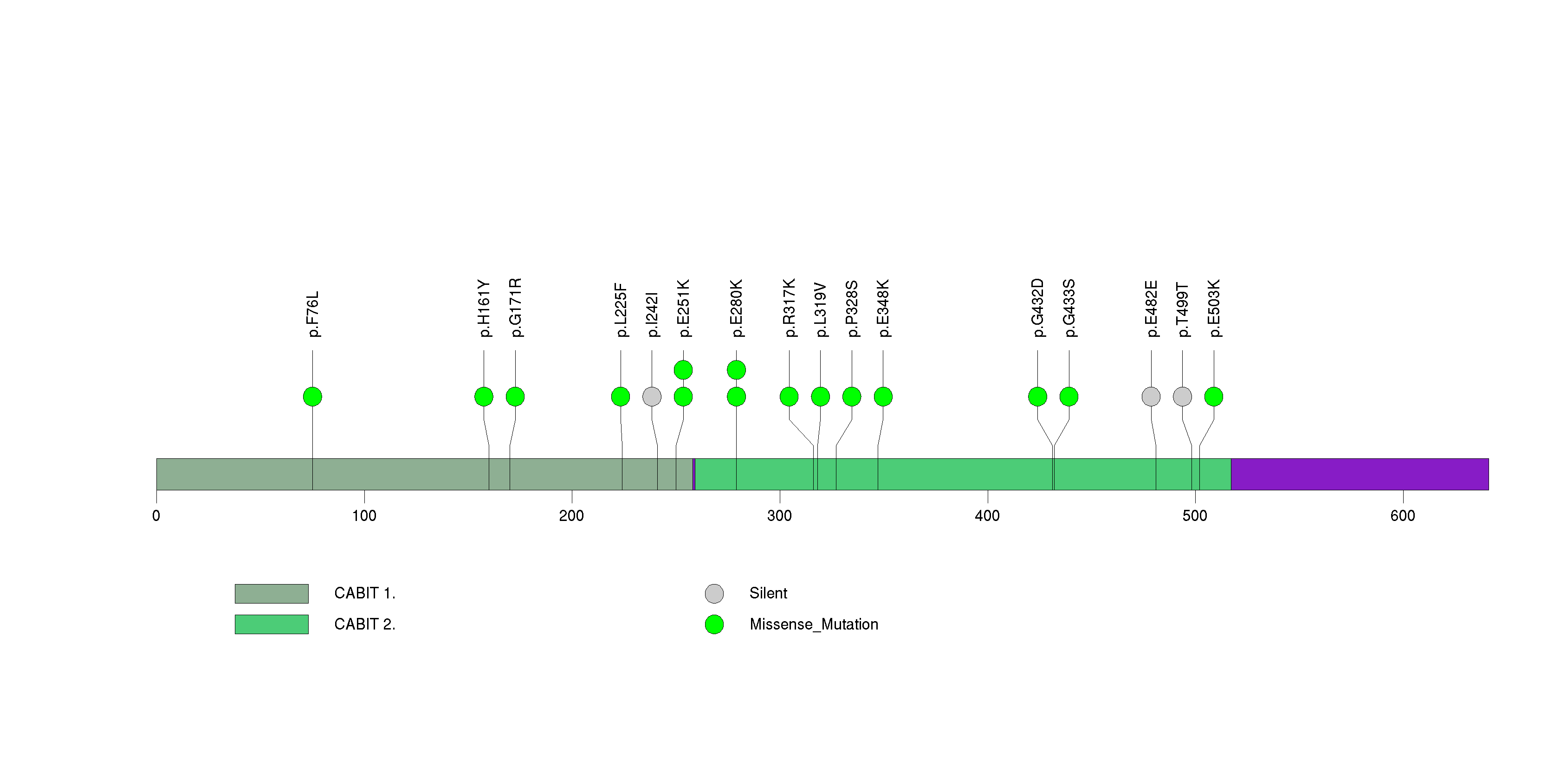
Figure S31. This figure depicts the distribution of mutations and mutation types across the LPPR1 significant gene.
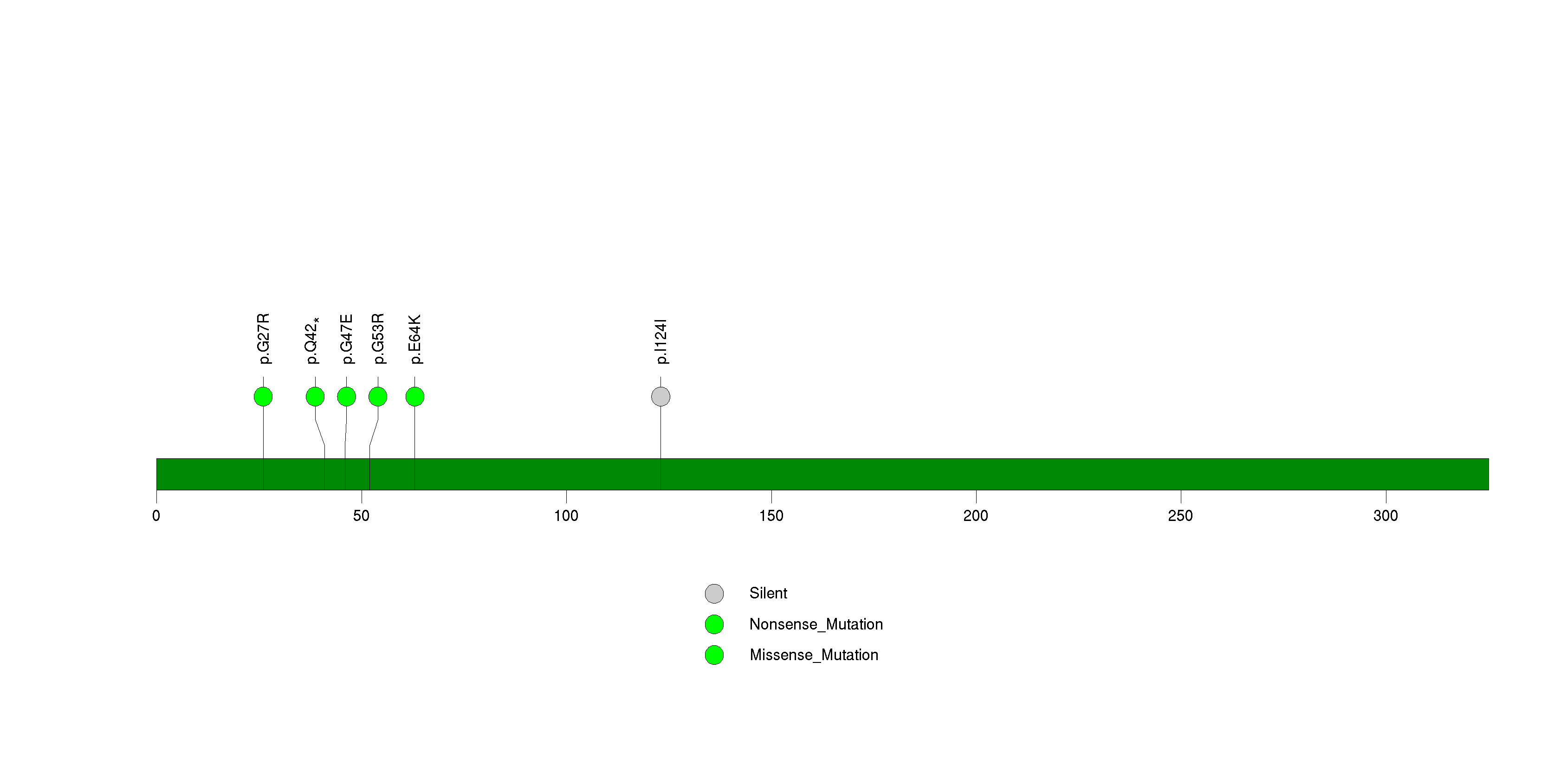
Figure S32. This figure depicts the distribution of mutations and mutation types across the C18orf34 significant gene.
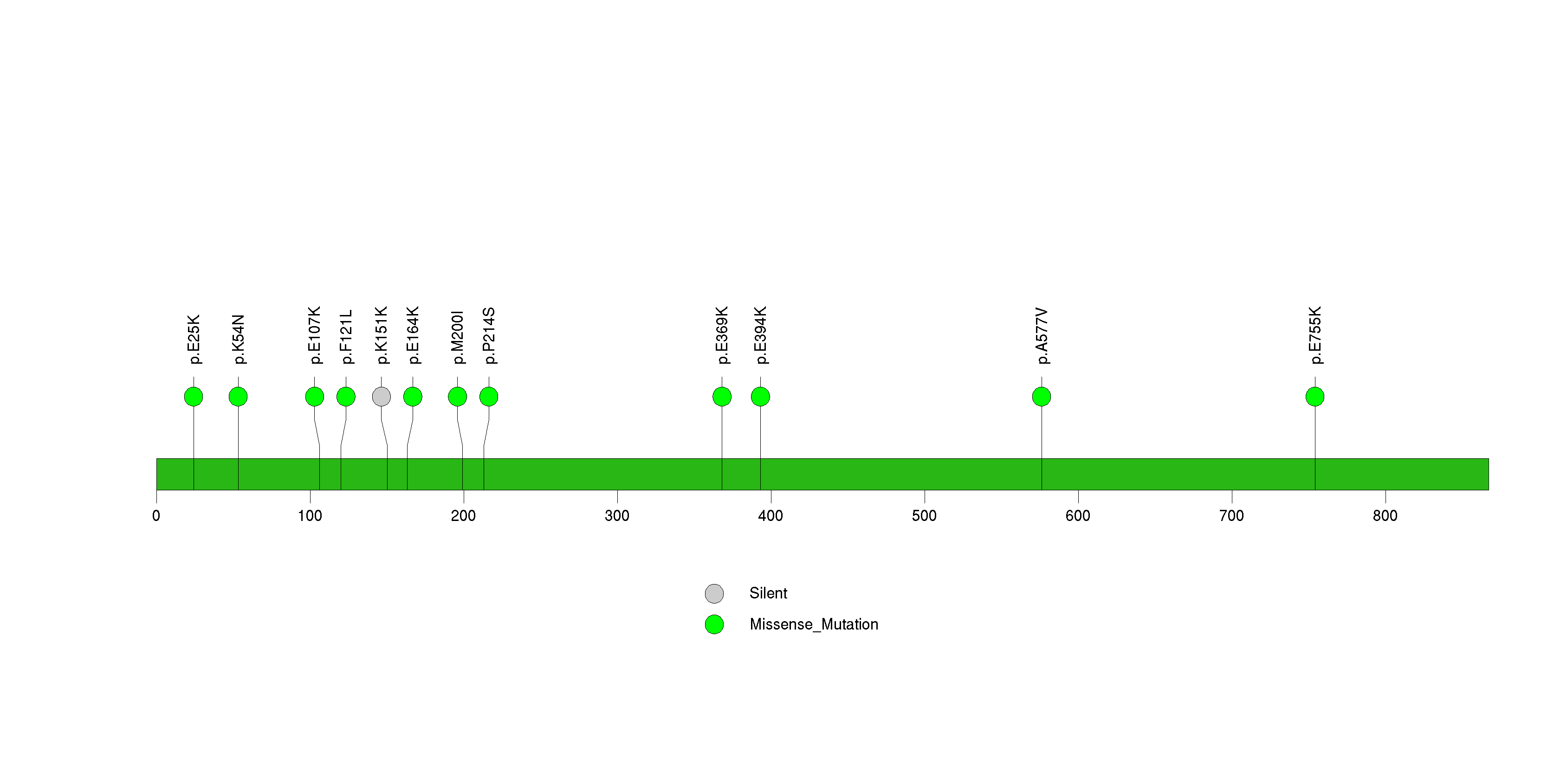
Figure S33. This figure depicts the distribution of mutations and mutation types across the FRG2B significant gene.
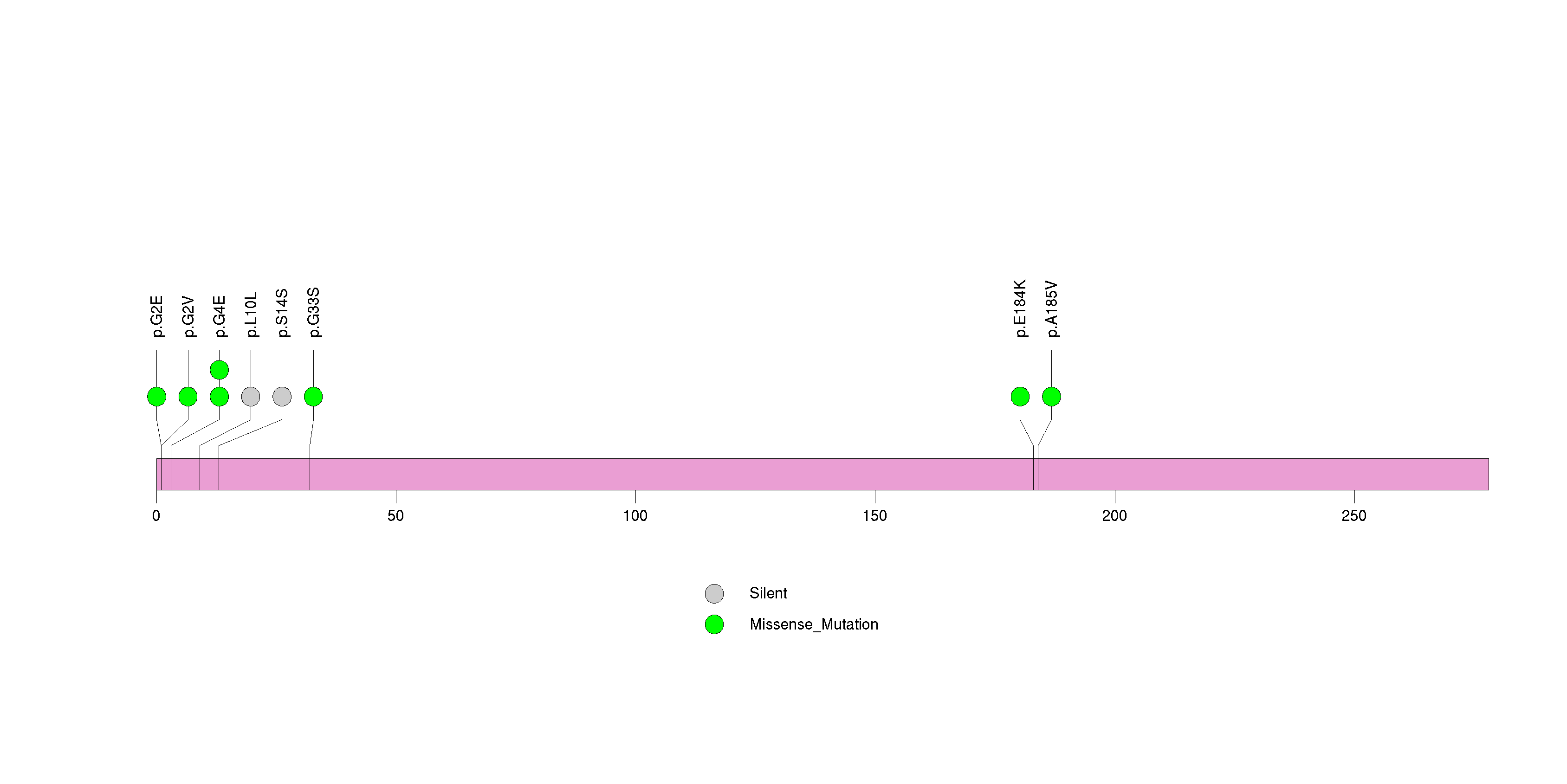
In this analysis, COSMIC is used as a filter to increase power by restricting the territory of each gene. Cosmic version: v48.
Table 4. Get Full Table Significantly mutated genes (COSMIC territory only). To access the database please go to: COSMIC. Number of significant genes found: 10. Number of genes displayed: 10
| rank | gene | description | n | cos | n_cos | N_cos | cos_ev | p | q |
|---|---|---|---|---|---|---|---|---|---|
| 1 | NRAS | neuroblastoma RAS viral (v-ras) oncogene homolog | 9 | 33 | 7 | 1023 | 8434 | 8.2e-14 | 2.5e-10 |
| 2 | BRAF | v-raf murine sarcoma viral oncogene homolog B1 | 9 | 89 | 9 | 2759 | 28833 | 1.1e-13 | 2.5e-10 |
| 3 | NF1 | neurofibromin 1 (neurofibromatosis, von Recklinghausen disease, Watson disease) | 38 | 285 | 10 | 8835 | 24 | 7.3e-12 | 1.1e-08 |
| 4 | TP53 | tumor protein p53 | 11 | 356 | 10 | 11036 | 732 | 6.1e-11 | 6.8e-08 |
| 5 | EPHA6 | EPH receptor A6 | 24 | 8 | 4 | 248 | 4 | 4.2e-10 | 3.8e-07 |
| 6 | CNTN5 | contactin 5 | 23 | 1 | 2 | 31 | 2 | 7.7e-07 | 0.00058 |
| 7 | CTNNA3 | catenin (cadherin-associated protein), alpha 3 | 13 | 2 | 2 | 62 | 2 | 3.1e-06 | 0.0018 |
| 8 | STK19 | serine/threonine kinase 19 | 4 | 2 | 2 | 62 | 4 | 3.1e-06 | 0.0018 |
| 9 | CDKN2A | cyclin-dependent kinase inhibitor 2A (melanoma, p16, inhibits CDK4) | 6 | 332 | 6 | 10292 | 217 | 5.2e-06 | 0.0026 |
| 10 | PDGFRA | platelet-derived growth factor receptor, alpha polypeptide | 9 | 69 | 3 | 2139 | 3 | 0.0001 | 0.046 |
Note:
n - number of (nonsilent) mutations in this gene across the individual set.
cos = number of unique mutated sites in this gene in COSMIC
n_cos = overlap between n and cos.
N_cos = number of individuals times cos.
cos_ev = total evidence: number of reports in COSMIC for mutations seen in this gene.
p = p-value for seeing the observed amount of overlap in this gene)
q = q-value, False Discovery Rate (Benjamini-Hochberg procedure)
Table 5. Get Full Table Genes with Clustered Mutations
| num | gene | desc | n | mindist | nmuts0 | nmuts3 | nmuts12 | npairs0 | npairs3 | npairs12 |
|---|---|---|---|---|---|---|---|---|---|---|
| 6179 | MUC16 | mucin 16, cell surface associated | 203 | 0 | 14 | 26 | 46 | 14 | 26 | 46 |
| 6612 | NRAS | neuroblastoma RAS viral (v-ras) oncogene homolog | 9 | 0 | 10 | 10 | 12 | 10 | 10 | 12 |
| 10471 | TTN | titin | 324 | 0 | 8 | 14 | 32 | 8 | 14 | 32 |
| 7310 | PCLO | piccolo (presynaptic cytomatrix protein) | 101 | 0 | 8 | 13 | 32 | 8 | 13 | 32 |
| 1166 | C15orf23 | chromosome 15 open reading frame 23 | 7 | 0 | 7 | 11 | 11 | 7 | 11 | 11 |
| 2850 | DNAH5 | dynein, axonemal, heavy chain 5 | 69 | 0 | 7 | 10 | 22 | 7 | 10 | 22 |
| 670 | ARMC4 | armadillo repeat containing 4 | 29 | 0 | 7 | 7 | 14 | 7 | 7 | 14 |
| 4947 | KCNB2 | potassium voltage-gated channel, Shab-related subfamily, member 2 | 21 | 0 | 6 | 8 | 10 | 6 | 8 | 10 |
| 3210 | EPHA6 | EPH receptor A6 | 24 | 0 | 6 | 6 | 19 | 6 | 6 | 19 |
| 8151 | RAC1 | ras-related C3 botulinum toxin substrate 1 (rho family, small GTP binding protein Rac1) | 5 | 0 | 6 | 6 | 10 | 6 | 6 | 10 |
Note:
n - number of mutations in this gene in the individual set.
mindist - distance (in aa) between closest pair of mutations in this gene
npairs3 - how many pairs of mutations are within 3 aa of each other.
npairs12 - how many pairs of mutations are within 12 aa of each other.
Table 6. Get Full Table A Ranked List of Significantly Mutated Genesets. (Source: MSigDB GSEA Cannonical Pathway Set).Number of significant genesets found: 0. Number of genesets displayed: 10
| rank | geneset | description | genes | N_genes | mut_tally | N | n | npat | nsite | nsil | n1 | n2 | n3 | n4 | n5 | n6 | p_ns_s | p | q |
|---|---|---|---|---|---|---|---|---|---|---|---|---|---|---|---|---|---|---|---|
| 1 | TERTPATHWAY | hTERC, the RNA subunit of telomerase, and hTERT, the catalytic protein subunit, are required for telomerase activity and are overexpressed in many cancers. | HDAC1, MAX, MYC, SP1, SP3, TP53, WT1, ZNF42 | 7 | MYC(2), SP1(2), TP53(11), WT1(3) | 324396 | 18 | 14 | 17 | 1 | 8 | 1 | 1 | 3 | 5 | 0 | 0.01 | 0.012 | 1 |
| 2 | SA_G1_AND_S_PHASES | Cdk2, 4, and 6 bind cyclin D in G1, while cdk2/cyclin E promotes the G1/S transition. | ARF1, ARF3, CCND1, CDK2, CDK4, CDKN1A, CDKN1B, CDKN2A, CFL1, E2F1, E2F2, MDM2, NXT1, PRB1, TP53 | 15 | CCND1(1), CDK4(2), CDKN1A(1), CDKN1B(1), CDKN2A(6), E2F1(2), E2F2(1), PRB1(8), TP53(11) | 386767 | 33 | 19 | 30 | 5 | 17 | 1 | 1 | 5 | 9 | 0 | 0.0051 | 0.019 | 1 |
| 3 | RECKPATHWAY | RECK is a membrane-anchored inhibitor of matrix metalloproteinases, which are expressed by tumor cells and promote metastasis. | HRAS, MMP14, MMP2, MMP9, RECK, TIMP1, TIMP2, TIMP3, TIMP4 | 9 | HRAS(2), MMP14(2), MMP2(3), MMP9(4), RECK(2), TIMP1(1), TIMP3(1), TIMP4(2) | 340497 | 17 | 15 | 17 | 2 | 10 | 2 | 1 | 4 | 0 | 0 | 0.019 | 0.038 | 1 |
| 4 | HSA00472_D_ARGININE_AND_D_ORNITHINE_METABOLISM | Genes involved in D-arginine and D-ornithine metabolism | DAO | 1 | DAO(4) | 32727 | 4 | 4 | 4 | 0 | 3 | 1 | 0 | 0 | 0 | 0 | 0.13 | 0.039 | 1 |
| 5 | SLRPPATHWAY | Small leucine-rich proteoglycans (SLRPs) interact with and reorganize collagen fibers in the extracellular matrix. | BGN, DCN, DSPG3, FMOD, KERA, LUM | 5 | BGN(2), DCN(6), FMOD(2), KERA(8), LUM(4) | 161484 | 22 | 15 | 22 | 5 | 16 | 2 | 3 | 1 | 0 | 0 | 0.016 | 0.045 | 1 |
| 6 | SA_REG_CASCADE_OF_CYCLIN_EXPR | Expression of cyclins regulates progression through the cell cycle by activating cyclin-dependent kinases. | CCNA1, CCNA2, CCND1, CCNE1, CCNE2, CDK2, CDK4, CDKN1B, CDKN2A, E2F1, E2F2, E2F4, PRB1 | 13 | CCNA1(2), CCND1(1), CCNE1(1), CCNE2(3), CDK4(2), CDKN1B(1), CDKN2A(6), E2F1(2), E2F2(1), E2F4(1), PRB1(8) | 412938 | 28 | 19 | 26 | 5 | 16 | 0 | 2 | 5 | 5 | 0 | 0.024 | 0.067 | 1 |
| 7 | BOTULINPATHWAY | Blockade of Neurotransmitter Relase by Botulinum Toxin | CHRM1, CHRNA1, SNAP25, STX1A, VAMP2 | 5 | CHRM1(2), CHRNA1(3), SNAP25(2), STX1A(1) | 149636 | 8 | 7 | 8 | 1 | 3 | 1 | 0 | 1 | 3 | 0 | 0.089 | 0.15 | 1 |
| 8 | FOSBPATHWAY | FOSB gene expression and drug abuse | CDK5, FOSB, GRIA2, JUND, PPP1R1B | 5 | FOSB(2), GRIA2(5), PPP1R1B(1) | 168715 | 8 | 8 | 7 | 1 | 6 | 0 | 0 | 0 | 2 | 0 | 0.11 | 0.22 | 1 |
| 9 | FBW7PATHWAY | Cyclin E interacts with cell cycle checkpoint kinase cdk2 to allow transcription of genes required for S phase, including transcription of additional cyclin E. | CCNE1, CDC34, CDK2, CUL1, E2F1, FBXW7, RB1, SKP1A, TFDP1 | 8 | CCNE1(1), CDC34(1), CUL1(2), E2F1(2), FBXW7(4), RB1(2), TFDP1(1) | 373766 | 13 | 10 | 13 | 2 | 5 | 1 | 2 | 1 | 3 | 1 | 0.071 | 0.27 | 1 |
| 10 | ARFPATHWAY | Cyclin-dependent kinase inhibitor 2A is a tumor suppressor that induces G1 arrest and can activate the p53 pathway, leading to G2/M arrest. | ABL1, CDKN2A, E2F1, MDM2, MYC, PIK3CA, PIK3R1, POLR1A, POLR1B, POLR1C, POLR1D, RAC1, RB1, TBX2, TP53, TWIST1 | 16 | ABL1(1), CDKN2A(6), E2F1(2), MYC(2), PIK3CA(3), POLR1A(5), POLR1B(4), RAC1(5), RB1(2), TBX2(2), TP53(11) | 926877 | 43 | 19 | 37 | 4 | 27 | 2 | 0 | 3 | 10 | 1 | 5e-05 | 0.31 | 1 |
Table 7. Get Full Table A Ranked List of Significantly Mutated Genesets (Excluding Significantly Mutated Genes). Number of significant genesets found: 0. Number of genesets displayed: 10
| rank | geneset | description | genes | N_genes | mut_tally | N | n | npat | nsite | nsil | n1 | n2 | n3 | n4 | n5 | n6 | p_ns_s | p | q |
|---|---|---|---|---|---|---|---|---|---|---|---|---|---|---|---|---|---|---|---|
| 1 | RECKPATHWAY | RECK is a membrane-anchored inhibitor of matrix metalloproteinases, which are expressed by tumor cells and promote metastasis. | HRAS, MMP14, MMP2, MMP9, RECK, TIMP1, TIMP2, TIMP3, TIMP4 | 9 | HRAS(2), MMP14(2), MMP2(3), MMP9(4), RECK(2), TIMP1(1), TIMP3(1), TIMP4(2) | 340497 | 17 | 15 | 17 | 2 | 10 | 2 | 1 | 4 | 0 | 0 | 0.019 | 0.038 | 1 |
| 2 | HSA00472_D_ARGININE_AND_D_ORNITHINE_METABOLISM | Genes involved in D-arginine and D-ornithine metabolism | DAO | 1 | DAO(4) | 32727 | 4 | 4 | 4 | 0 | 3 | 1 | 0 | 0 | 0 | 0 | 0.13 | 0.039 | 1 |
| 3 | SLRPPATHWAY | Small leucine-rich proteoglycans (SLRPs) interact with and reorganize collagen fibers in the extracellular matrix. | BGN, DCN, DSPG3, FMOD, KERA, LUM | 5 | BGN(2), DCN(6), FMOD(2), KERA(8), LUM(4) | 161484 | 22 | 15 | 22 | 5 | 16 | 2 | 3 | 1 | 0 | 0 | 0.016 | 0.045 | 1 |
| 4 | BOTULINPATHWAY | Blockade of Neurotransmitter Relase by Botulinum Toxin | CHRM1, CHRNA1, SNAP25, STX1A, VAMP2 | 5 | CHRM1(2), CHRNA1(3), SNAP25(2), STX1A(1) | 149636 | 8 | 7 | 8 | 1 | 3 | 1 | 0 | 1 | 3 | 0 | 0.089 | 0.15 | 1 |
| 5 | FOSBPATHWAY | FOSB gene expression and drug abuse | CDK5, FOSB, GRIA2, JUND, PPP1R1B | 5 | FOSB(2), GRIA2(5), PPP1R1B(1) | 168715 | 8 | 8 | 7 | 1 | 6 | 0 | 0 | 0 | 2 | 0 | 0.11 | 0.22 | 1 |
| 6 | FBW7PATHWAY | Cyclin E interacts with cell cycle checkpoint kinase cdk2 to allow transcription of genes required for S phase, including transcription of additional cyclin E. | CCNE1, CDC34, CDK2, CUL1, E2F1, FBXW7, RB1, SKP1A, TFDP1 | 8 | CCNE1(1), CDC34(1), CUL1(2), E2F1(2), FBXW7(4), RB1(2), TFDP1(1) | 373766 | 13 | 10 | 13 | 2 | 5 | 1 | 2 | 1 | 3 | 1 | 0.071 | 0.27 | 1 |
| 7 | RIBOFLAVIN_METABOLISM | ACP1, ACP2, ACP5, ACPP, ACPT, ENPP1, ENPP3, FLAD1, RFK, TYR | 10 | ACP5(1), ACPP(2), ENPP1(4), ENPP3(7), FLAD1(2), TYR(3) | 440888 | 19 | 13 | 19 | 2 | 12 | 1 | 1 | 1 | 4 | 0 | 0.013 | 0.37 | 1 | |
| 8 | HSA00627_1,4_DICHLOROBENZENE_DEGRADATION | Genes involved in 1,4-dichlorobenzene degradation | CMBL | 1 | CMBL(1) | 23498 | 1 | 1 | 1 | 0 | 1 | 0 | 0 | 0 | 0 | 0 | 0.68 | 0.38 | 1 |
| 9 | FLUMAZENILPATHWAY | Flumazenil is a benzodiazepine receptor antagonist that may induce protective preconditioning in ischemic cardiomyocytes. | GABRA1, GABRA2, GABRA3, GABRA4, GABRA5, GABRA6, GPX1, PRKCE, SOD1 | 9 | GABRA1(6), GABRA2(4), GABRA3(6), GABRA4(3), GABRA5(1), GABRA6(8), PRKCE(2) | 352674 | 30 | 17 | 28 | 8 | 21 | 2 | 1 | 4 | 2 | 0 | 0.035 | 0.4 | 1 |
| 10 | EOSINOPHILSPATHWAY | Recruitment of eosinophils in the inflammatory response observed in asthma occurs via the chemoattractant eotaxin binding to the CCR3 receptor. | CCL11, CCL5, CCR3, CSF2, HLA-DRA, HLA-DRB1, IL3, IL5 | 8 | CCR3(3), HLA-DRA(3), HLA-DRB1(2) | 138490 | 8 | 7 | 8 | 3 | 7 | 0 | 0 | 0 | 1 | 0 | 0.18 | 0.44 | 1 |
In brief, we tabulate the number of mutations and the number of covered bases for each gene. The counts are broken down by mutation context category: four context categories that are discovered by MutSig, and one for indel and 'null' mutations, which include indels, nonsense mutations, splice-site mutations, and non-stop (read-through) mutations. For each gene, we calculate the probability of seeing the observed constellation of mutations, i.e. the product P1 x P2 x ... x Pm, or a more extreme one, given the background mutation rates calculated across the dataset. [1]
This is an experimental feature. The full results of the analysis summarized in this report can be downloaded from the TCGA Data Coordination Center.